Rolls Royce ERP Implementation
VerifiedAdded on 2021/05/30
|20
|4563
|494
AI Summary
Contribute Materials
Your contribution can guide someone’s learning journey. Share your
documents today.
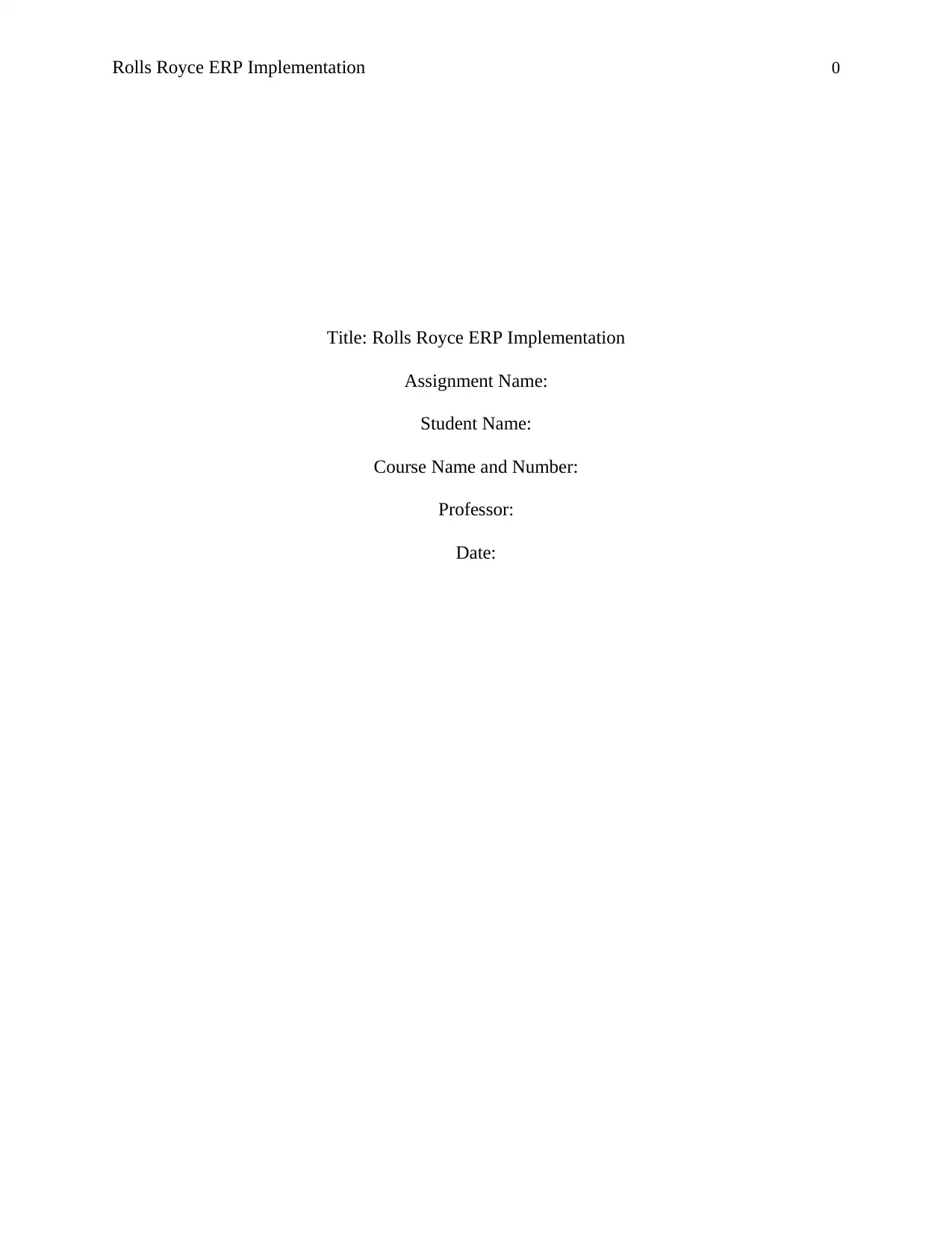
Rolls Royce ERP Implementation 0
Title: Rolls Royce ERP Implementation
Assignment Name:
Student Name:
Course Name and Number:
Professor:
Date:
Title: Rolls Royce ERP Implementation
Assignment Name:
Student Name:
Course Name and Number:
Professor:
Date:
Secure Best Marks with AI Grader
Need help grading? Try our AI Grader for instant feedback on your assignments.
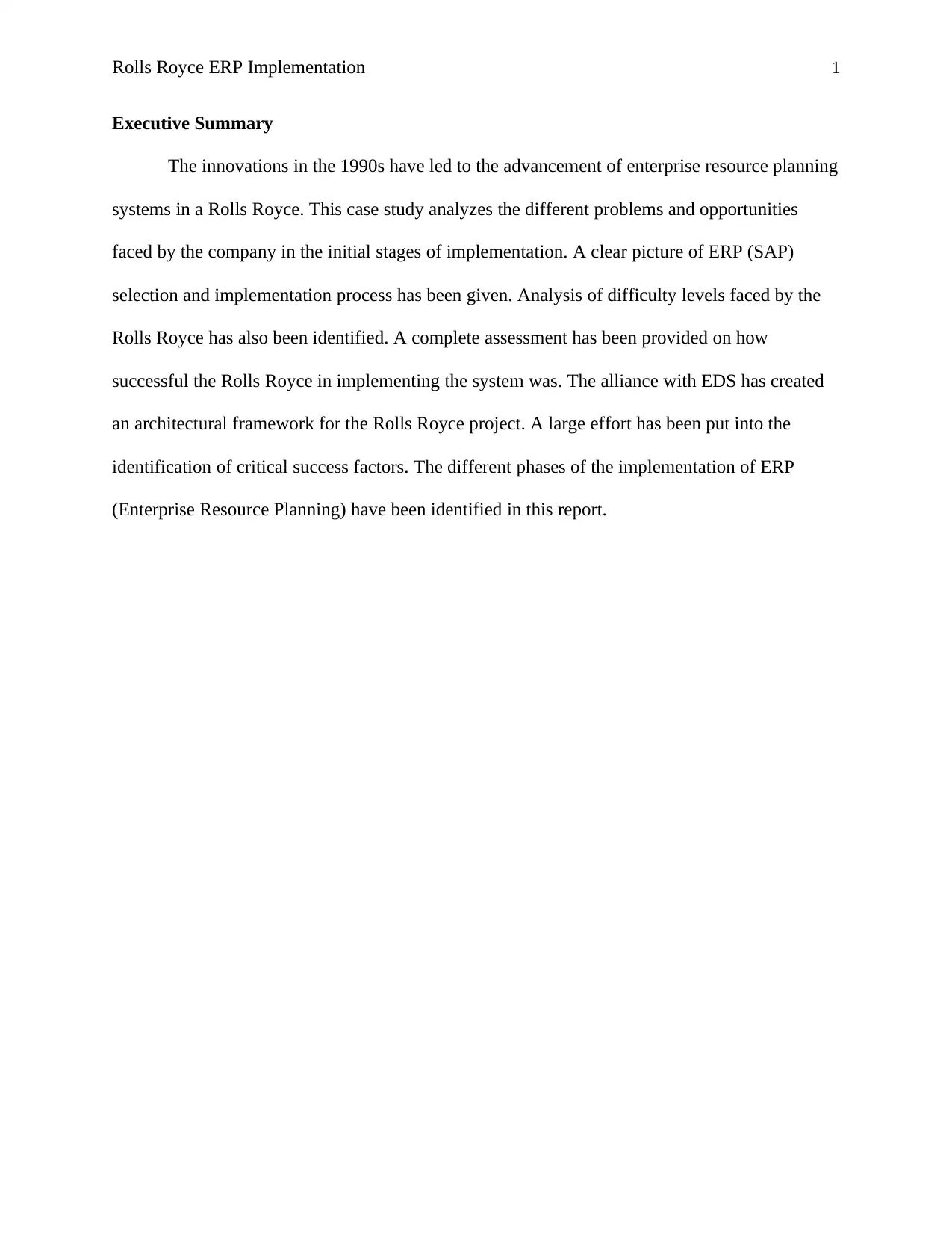
Rolls Royce ERP Implementation 1
Executive Summary
The innovations in the 1990s have led to the advancement of enterprise resource planning
systems in a Rolls Royce. This case study analyzes the different problems and opportunities
faced by the company in the initial stages of implementation. A clear picture of ERP (SAP)
selection and implementation process has been given. Analysis of difficulty levels faced by the
Rolls Royce has also been identified. A complete assessment has been provided on how
successful the Rolls Royce in implementing the system was. The alliance with EDS has created
an architectural framework for the Rolls Royce project. A large effort has been put into the
identification of critical success factors. The different phases of the implementation of ERP
(Enterprise Resource Planning) have been identified in this report.
Executive Summary
The innovations in the 1990s have led to the advancement of enterprise resource planning
systems in a Rolls Royce. This case study analyzes the different problems and opportunities
faced by the company in the initial stages of implementation. A clear picture of ERP (SAP)
selection and implementation process has been given. Analysis of difficulty levels faced by the
Rolls Royce has also been identified. A complete assessment has been provided on how
successful the Rolls Royce in implementing the system was. The alliance with EDS has created
an architectural framework for the Rolls Royce project. A large effort has been put into the
identification of critical success factors. The different phases of the implementation of ERP
(Enterprise Resource Planning) have been identified in this report.
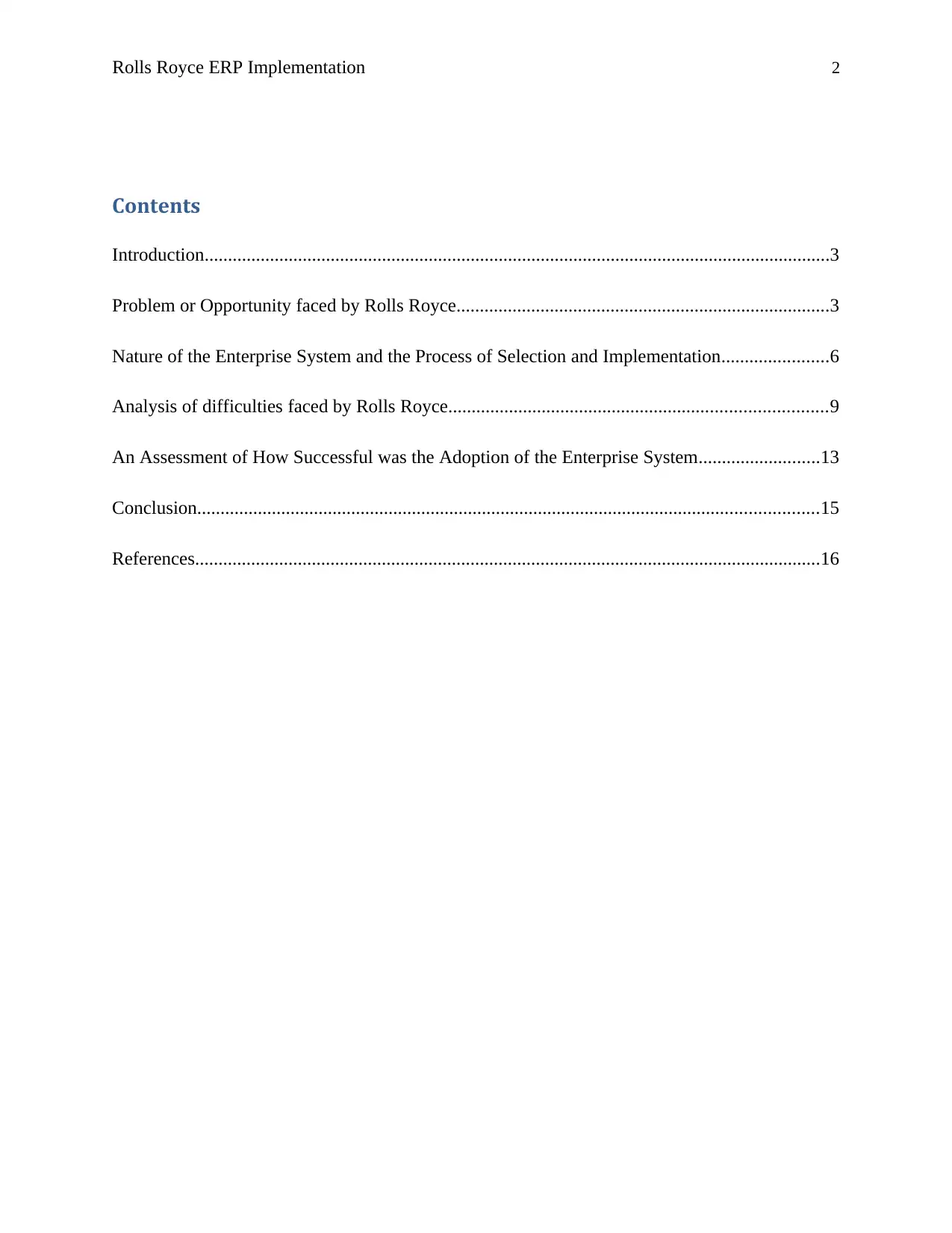
Rolls Royce ERP Implementation 2
Contents
Introduction......................................................................................................................................3
Problem or Opportunity faced by Rolls Royce................................................................................3
Nature of the Enterprise System and the Process of Selection and Implementation.......................6
Analysis of difficulties faced by Rolls Royce.................................................................................9
An Assessment of How Successful was the Adoption of the Enterprise System..........................13
Conclusion.....................................................................................................................................15
References......................................................................................................................................16
Contents
Introduction......................................................................................................................................3
Problem or Opportunity faced by Rolls Royce................................................................................3
Nature of the Enterprise System and the Process of Selection and Implementation.......................6
Analysis of difficulties faced by Rolls Royce.................................................................................9
An Assessment of How Successful was the Adoption of the Enterprise System..........................13
Conclusion.....................................................................................................................................15
References......................................................................................................................................16
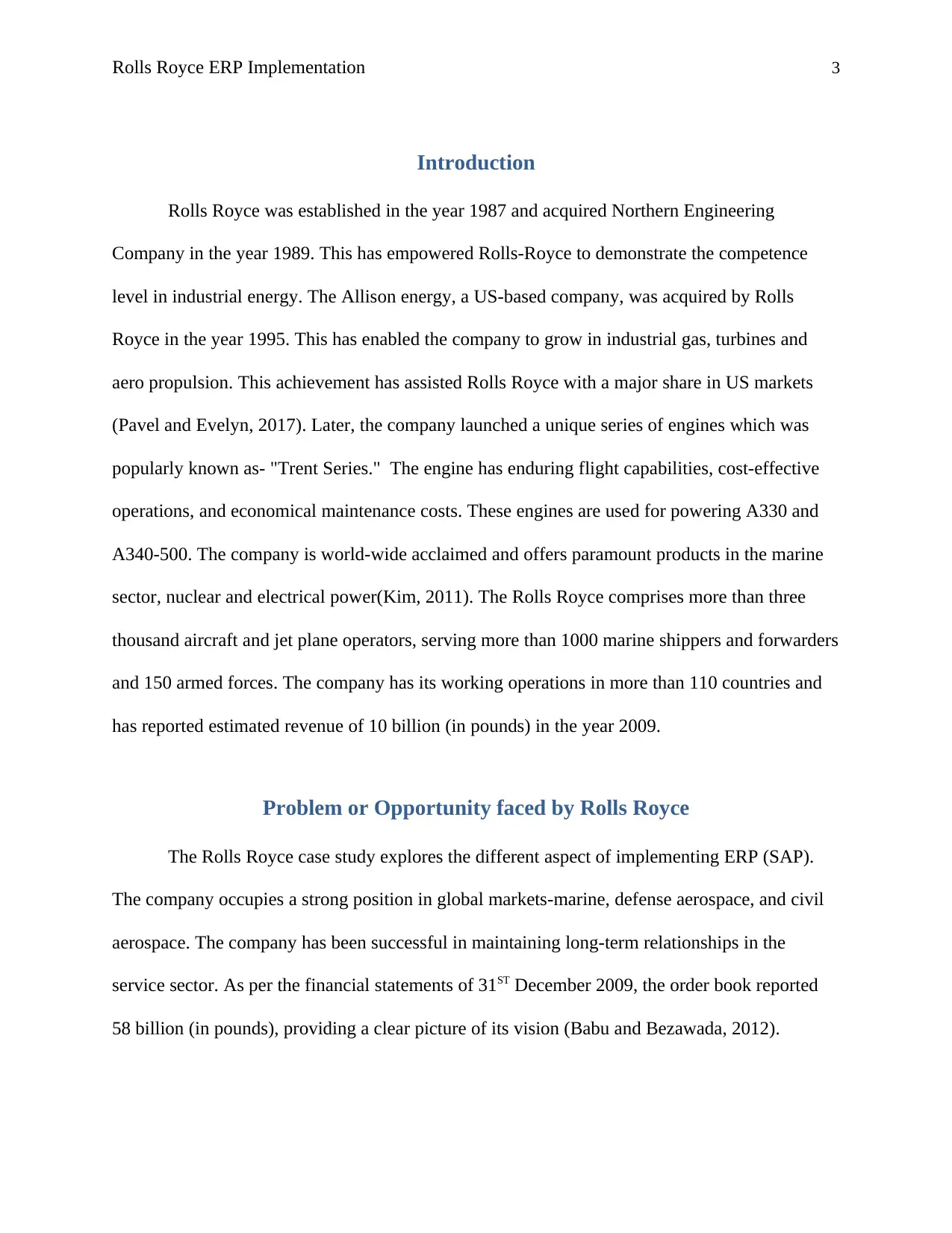
Rolls Royce ERP Implementation 3
Introduction
Rolls Royce was established in the year 1987 and acquired Northern Engineering
Company in the year 1989. This has empowered Rolls-Royce to demonstrate the competence
level in industrial energy. The Allison energy, a US-based company, was acquired by Rolls
Royce in the year 1995. This has enabled the company to grow in industrial gas, turbines and
aero propulsion. This achievement has assisted Rolls Royce with a major share in US markets
(Pavel and Evelyn, 2017). Later, the company launched a unique series of engines which was
popularly known as- "Trent Series." The engine has enduring flight capabilities, cost-effective
operations, and economical maintenance costs. These engines are used for powering A330 and
A340-500. The company is world-wide acclaimed and offers paramount products in the marine
sector, nuclear and electrical power(Kim, 2011). The Rolls Royce comprises more than three
thousand aircraft and jet plane operators, serving more than 1000 marine shippers and forwarders
and 150 armed forces. The company has its working operations in more than 110 countries and
has reported estimated revenue of 10 billion (in pounds) in the year 2009.
Problem or Opportunity faced by Rolls Royce
The Rolls Royce case study explores the different aspect of implementing ERP (SAP).
The company occupies a strong position in global markets-marine, defense aerospace, and civil
aerospace. The company has been successful in maintaining long-term relationships in the
service sector. As per the financial statements of 31ST December 2009, the order book reported
58 billion (in pounds), providing a clear picture of its vision (Babu and Bezawada, 2012).
Introduction
Rolls Royce was established in the year 1987 and acquired Northern Engineering
Company in the year 1989. This has empowered Rolls-Royce to demonstrate the competence
level in industrial energy. The Allison energy, a US-based company, was acquired by Rolls
Royce in the year 1995. This has enabled the company to grow in industrial gas, turbines and
aero propulsion. This achievement has assisted Rolls Royce with a major share in US markets
(Pavel and Evelyn, 2017). Later, the company launched a unique series of engines which was
popularly known as- "Trent Series." The engine has enduring flight capabilities, cost-effective
operations, and economical maintenance costs. These engines are used for powering A330 and
A340-500. The company is world-wide acclaimed and offers paramount products in the marine
sector, nuclear and electrical power(Kim, 2011). The Rolls Royce comprises more than three
thousand aircraft and jet plane operators, serving more than 1000 marine shippers and forwarders
and 150 armed forces. The company has its working operations in more than 110 countries and
has reported estimated revenue of 10 billion (in pounds) in the year 2009.
Problem or Opportunity faced by Rolls Royce
The Rolls Royce case study explores the different aspect of implementing ERP (SAP).
The company occupies a strong position in global markets-marine, defense aerospace, and civil
aerospace. The company has been successful in maintaining long-term relationships in the
service sector. As per the financial statements of 31ST December 2009, the order book reported
58 billion (in pounds), providing a clear picture of its vision (Babu and Bezawada, 2012).
Secure Best Marks with AI Grader
Need help grading? Try our AI Grader for instant feedback on your assignments.
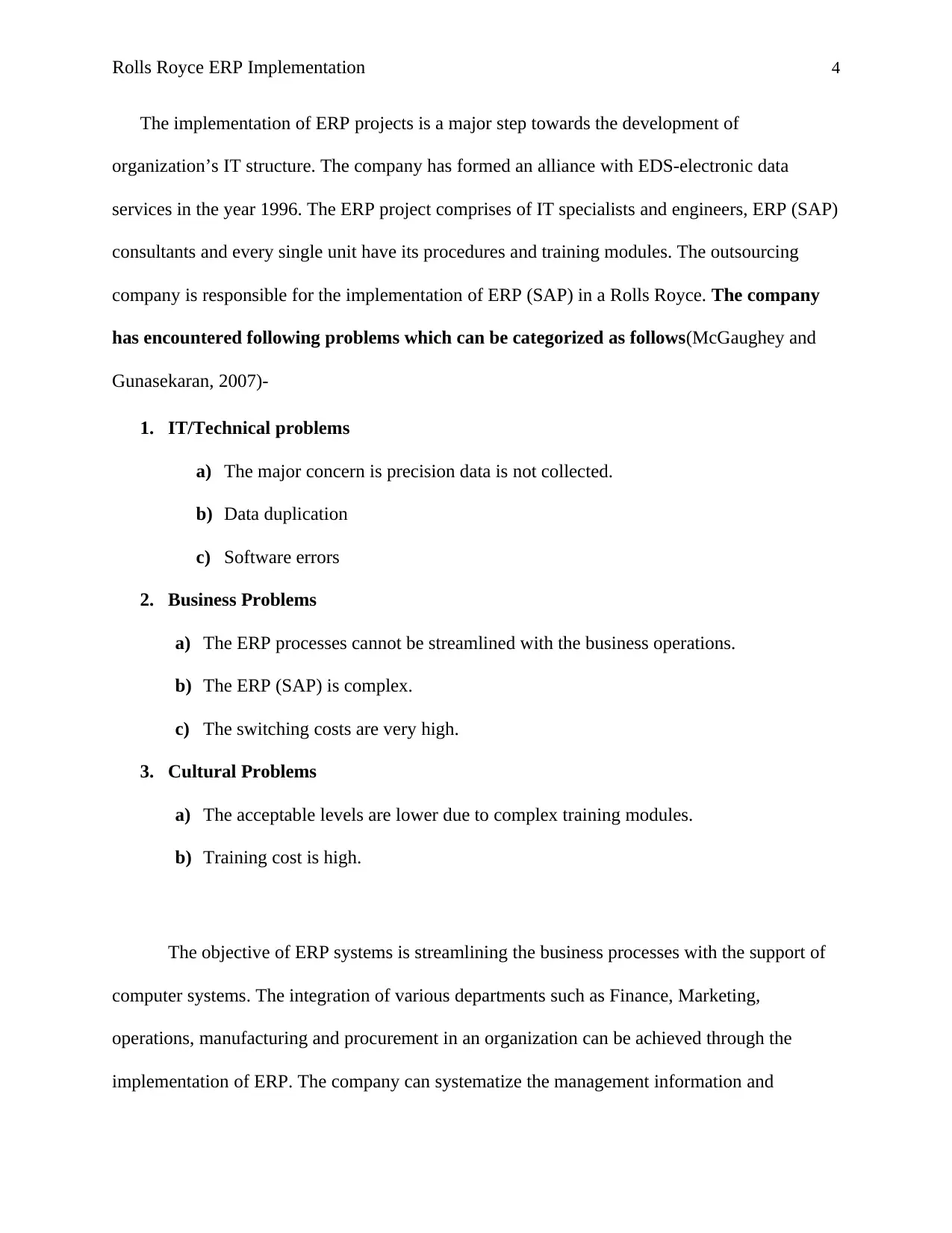
Rolls Royce ERP Implementation 4
The implementation of ERP projects is a major step towards the development of
organization’s IT structure. The company has formed an alliance with EDS-electronic data
services in the year 1996. The ERP project comprises of IT specialists and engineers, ERP (SAP)
consultants and every single unit have its procedures and training modules. The outsourcing
company is responsible for the implementation of ERP (SAP) in a Rolls Royce. The company
has encountered following problems which can be categorized as follows(McGaughey and
Gunasekaran, 2007)-
1. IT/Technical problems
a) The major concern is precision data is not collected.
b) Data duplication
c) Software errors
2. Business Problems
a) The ERP processes cannot be streamlined with the business operations.
b) The ERP (SAP) is complex.
c) The switching costs are very high.
3. Cultural Problems
a) The acceptable levels are lower due to complex training modules.
b) Training cost is high.
The objective of ERP systems is streamlining the business processes with the support of
computer systems. The integration of various departments such as Finance, Marketing,
operations, manufacturing and procurement in an organization can be achieved through the
implementation of ERP. The company can systematize the management information and
The implementation of ERP projects is a major step towards the development of
organization’s IT structure. The company has formed an alliance with EDS-electronic data
services in the year 1996. The ERP project comprises of IT specialists and engineers, ERP (SAP)
consultants and every single unit have its procedures and training modules. The outsourcing
company is responsible for the implementation of ERP (SAP) in a Rolls Royce. The company
has encountered following problems which can be categorized as follows(McGaughey and
Gunasekaran, 2007)-
1. IT/Technical problems
a) The major concern is precision data is not collected.
b) Data duplication
c) Software errors
2. Business Problems
a) The ERP processes cannot be streamlined with the business operations.
b) The ERP (SAP) is complex.
c) The switching costs are very high.
3. Cultural Problems
a) The acceptable levels are lower due to complex training modules.
b) Training cost is high.
The objective of ERP systems is streamlining the business processes with the support of
computer systems. The integration of various departments such as Finance, Marketing,
operations, manufacturing and procurement in an organization can be achieved through the
implementation of ERP. The company can systematize the management information and
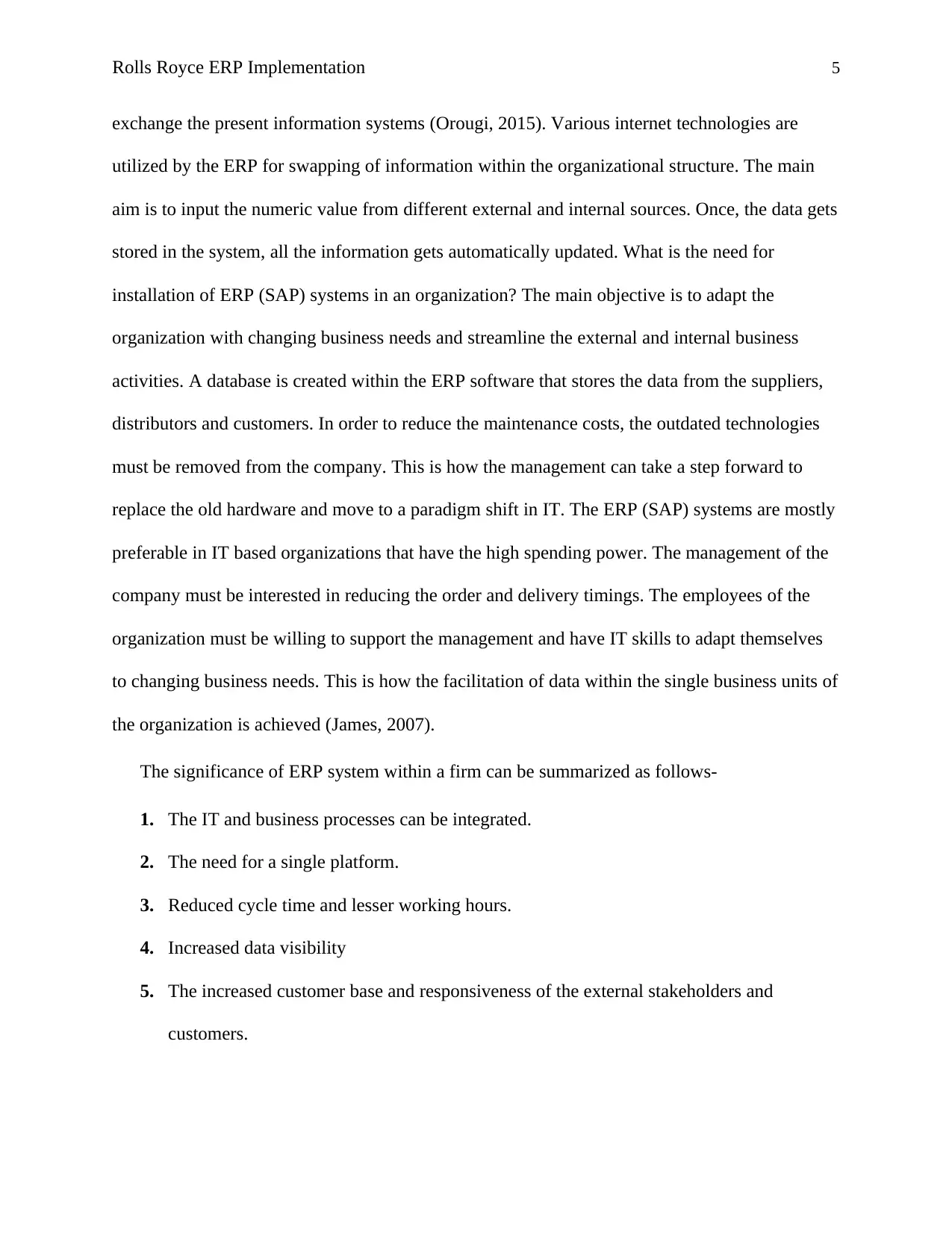
Rolls Royce ERP Implementation 5
exchange the present information systems (Orougi, 2015). Various internet technologies are
utilized by the ERP for swapping of information within the organizational structure. The main
aim is to input the numeric value from different external and internal sources. Once, the data gets
stored in the system, all the information gets automatically updated. What is the need for
installation of ERP (SAP) systems in an organization? The main objective is to adapt the
organization with changing business needs and streamline the external and internal business
activities. A database is created within the ERP software that stores the data from the suppliers,
distributors and customers. In order to reduce the maintenance costs, the outdated technologies
must be removed from the company. This is how the management can take a step forward to
replace the old hardware and move to a paradigm shift in IT. The ERP (SAP) systems are mostly
preferable in IT based organizations that have the high spending power. The management of the
company must be interested in reducing the order and delivery timings. The employees of the
organization must be willing to support the management and have IT skills to adapt themselves
to changing business needs. This is how the facilitation of data within the single business units of
the organization is achieved (James, 2007).
The significance of ERP system within a firm can be summarized as follows-
1. The IT and business processes can be integrated.
2. The need for a single platform.
3. Reduced cycle time and lesser working hours.
4. Increased data visibility
5. The increased customer base and responsiveness of the external stakeholders and
customers.
exchange the present information systems (Orougi, 2015). Various internet technologies are
utilized by the ERP for swapping of information within the organizational structure. The main
aim is to input the numeric value from different external and internal sources. Once, the data gets
stored in the system, all the information gets automatically updated. What is the need for
installation of ERP (SAP) systems in an organization? The main objective is to adapt the
organization with changing business needs and streamline the external and internal business
activities. A database is created within the ERP software that stores the data from the suppliers,
distributors and customers. In order to reduce the maintenance costs, the outdated technologies
must be removed from the company. This is how the management can take a step forward to
replace the old hardware and move to a paradigm shift in IT. The ERP (SAP) systems are mostly
preferable in IT based organizations that have the high spending power. The management of the
company must be interested in reducing the order and delivery timings. The employees of the
organization must be willing to support the management and have IT skills to adapt themselves
to changing business needs. This is how the facilitation of data within the single business units of
the organization is achieved (James, 2007).
The significance of ERP system within a firm can be summarized as follows-
1. The IT and business processes can be integrated.
2. The need for a single platform.
3. Reduced cycle time and lesser working hours.
4. Increased data visibility
5. The increased customer base and responsiveness of the external stakeholders and
customers.
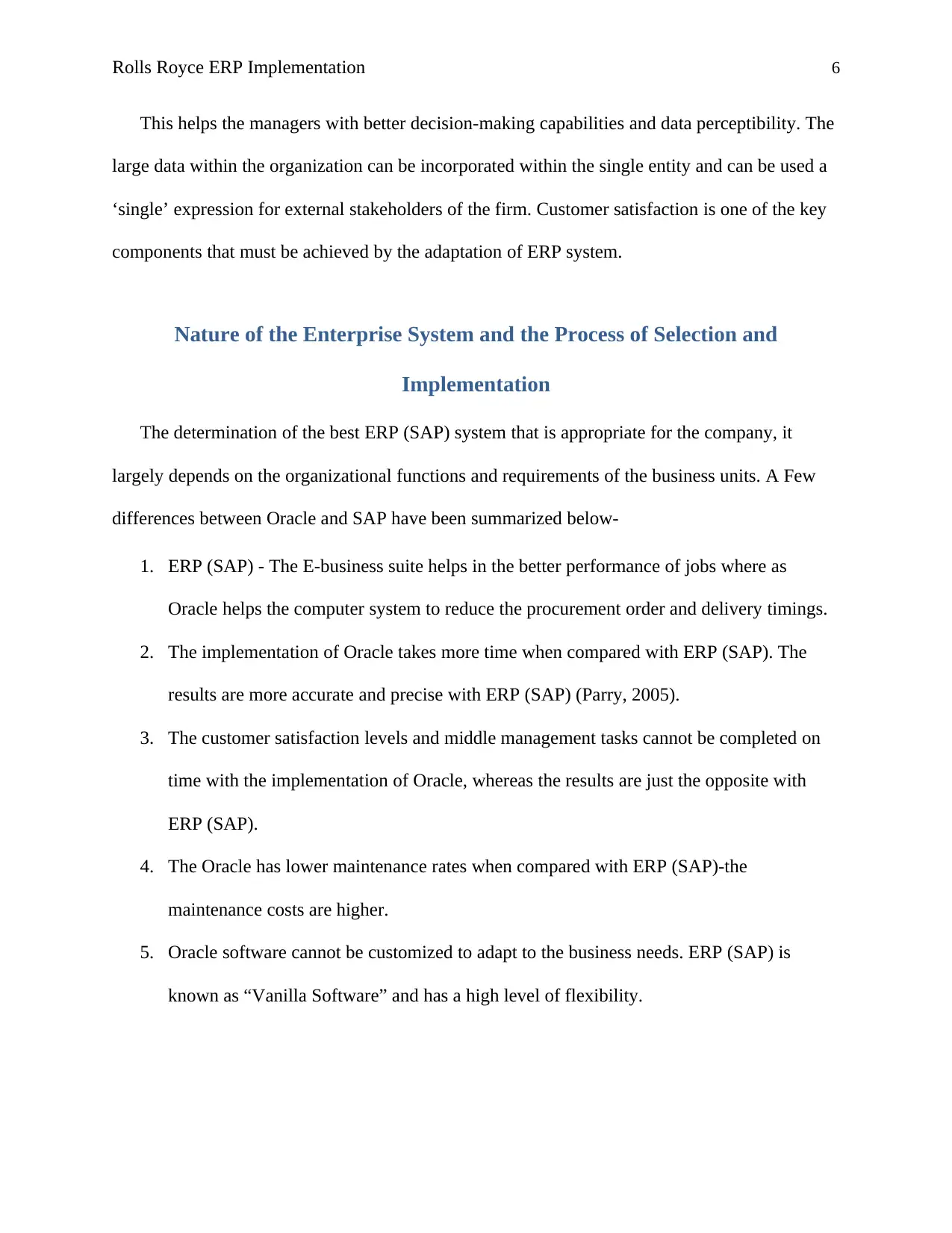
Rolls Royce ERP Implementation 6
This helps the managers with better decision-making capabilities and data perceptibility. The
large data within the organization can be incorporated within the single entity and can be used a
‘single’ expression for external stakeholders of the firm. Customer satisfaction is one of the key
components that must be achieved by the adaptation of ERP system.
Nature of the Enterprise System and the Process of Selection and
Implementation
The determination of the best ERP (SAP) system that is appropriate for the company, it
largely depends on the organizational functions and requirements of the business units. A Few
differences between Oracle and SAP have been summarized below-
1. ERP (SAP) - The E-business suite helps in the better performance of jobs where as
Oracle helps the computer system to reduce the procurement order and delivery timings.
2. The implementation of Oracle takes more time when compared with ERP (SAP). The
results are more accurate and precise with ERP (SAP) (Parry, 2005).
3. The customer satisfaction levels and middle management tasks cannot be completed on
time with the implementation of Oracle, whereas the results are just the opposite with
ERP (SAP).
4. The Oracle has lower maintenance rates when compared with ERP (SAP)-the
maintenance costs are higher.
5. Oracle software cannot be customized to adapt to the business needs. ERP (SAP) is
known as “Vanilla Software” and has a high level of flexibility.
This helps the managers with better decision-making capabilities and data perceptibility. The
large data within the organization can be incorporated within the single entity and can be used a
‘single’ expression for external stakeholders of the firm. Customer satisfaction is one of the key
components that must be achieved by the adaptation of ERP system.
Nature of the Enterprise System and the Process of Selection and
Implementation
The determination of the best ERP (SAP) system that is appropriate for the company, it
largely depends on the organizational functions and requirements of the business units. A Few
differences between Oracle and SAP have been summarized below-
1. ERP (SAP) - The E-business suite helps in the better performance of jobs where as
Oracle helps the computer system to reduce the procurement order and delivery timings.
2. The implementation of Oracle takes more time when compared with ERP (SAP). The
results are more accurate and precise with ERP (SAP) (Parry, 2005).
3. The customer satisfaction levels and middle management tasks cannot be completed on
time with the implementation of Oracle, whereas the results are just the opposite with
ERP (SAP).
4. The Oracle has lower maintenance rates when compared with ERP (SAP)-the
maintenance costs are higher.
5. Oracle software cannot be customized to adapt to the business needs. ERP (SAP) is
known as “Vanilla Software” and has a high level of flexibility.
Paraphrase This Document
Need a fresh take? Get an instant paraphrase of this document with our AI Paraphraser
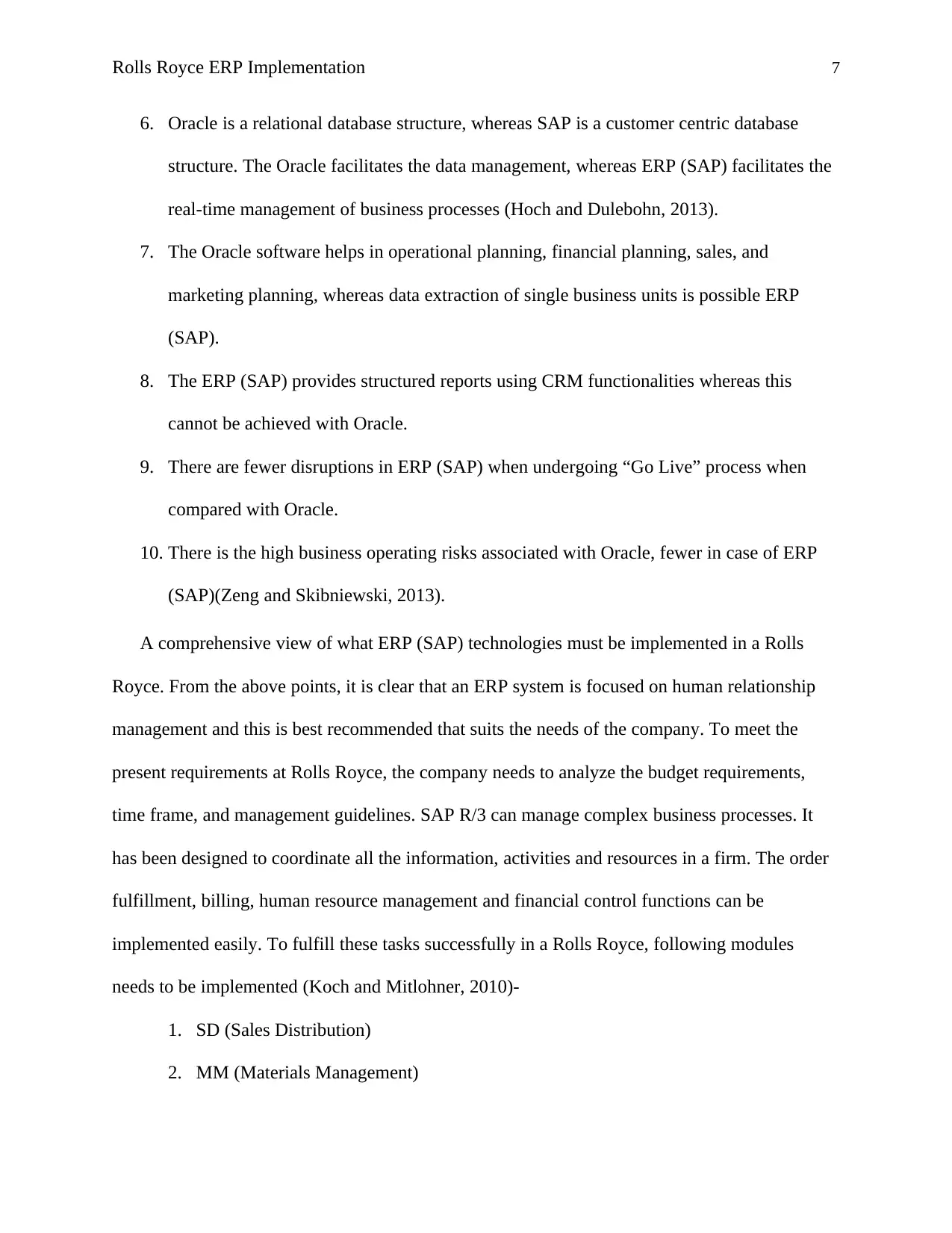
Rolls Royce ERP Implementation 7
6. Oracle is a relational database structure, whereas SAP is a customer centric database
structure. The Oracle facilitates the data management, whereas ERP (SAP) facilitates the
real-time management of business processes (Hoch and Dulebohn, 2013).
7. The Oracle software helps in operational planning, financial planning, sales, and
marketing planning, whereas data extraction of single business units is possible ERP
(SAP).
8. The ERP (SAP) provides structured reports using CRM functionalities whereas this
cannot be achieved with Oracle.
9. There are fewer disruptions in ERP (SAP) when undergoing “Go Live” process when
compared with Oracle.
10. There is the high business operating risks associated with Oracle, fewer in case of ERP
(SAP)(Zeng and Skibniewski, 2013).
A comprehensive view of what ERP (SAP) technologies must be implemented in a Rolls
Royce. From the above points, it is clear that an ERP system is focused on human relationship
management and this is best recommended that suits the needs of the company. To meet the
present requirements at Rolls Royce, the company needs to analyze the budget requirements,
time frame, and management guidelines. SAP R/3 can manage complex business processes. It
has been designed to coordinate all the information, activities and resources in a firm. The order
fulfillment, billing, human resource management and financial control functions can be
implemented easily. To fulfill these tasks successfully in a Rolls Royce, following modules
needs to be implemented (Koch and Mitlohner, 2010)-
1. SD (Sales Distribution)
2. MM (Materials Management)
6. Oracle is a relational database structure, whereas SAP is a customer centric database
structure. The Oracle facilitates the data management, whereas ERP (SAP) facilitates the
real-time management of business processes (Hoch and Dulebohn, 2013).
7. The Oracle software helps in operational planning, financial planning, sales, and
marketing planning, whereas data extraction of single business units is possible ERP
(SAP).
8. The ERP (SAP) provides structured reports using CRM functionalities whereas this
cannot be achieved with Oracle.
9. There are fewer disruptions in ERP (SAP) when undergoing “Go Live” process when
compared with Oracle.
10. There is the high business operating risks associated with Oracle, fewer in case of ERP
(SAP)(Zeng and Skibniewski, 2013).
A comprehensive view of what ERP (SAP) technologies must be implemented in a Rolls
Royce. From the above points, it is clear that an ERP system is focused on human relationship
management and this is best recommended that suits the needs of the company. To meet the
present requirements at Rolls Royce, the company needs to analyze the budget requirements,
time frame, and management guidelines. SAP R/3 can manage complex business processes. It
has been designed to coordinate all the information, activities and resources in a firm. The order
fulfillment, billing, human resource management and financial control functions can be
implemented easily. To fulfill these tasks successfully in a Rolls Royce, following modules
needs to be implemented (Koch and Mitlohner, 2010)-
1. SD (Sales Distribution)
2. MM (Materials Management)
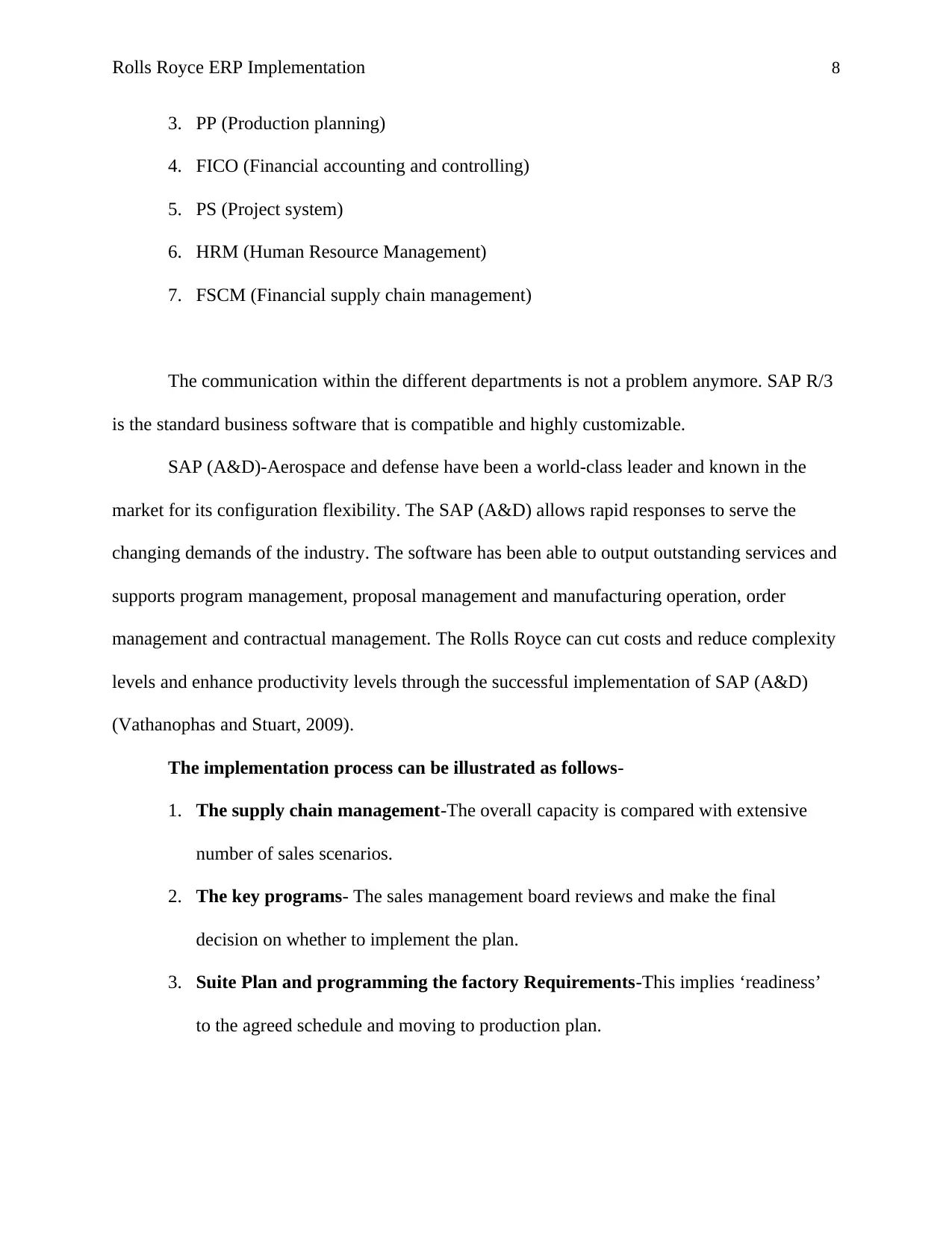
Rolls Royce ERP Implementation 8
3. PP (Production planning)
4. FICO (Financial accounting and controlling)
5. PS (Project system)
6. HRM (Human Resource Management)
7. FSCM (Financial supply chain management)
The communication within the different departments is not a problem anymore. SAP R/3
is the standard business software that is compatible and highly customizable.
SAP (A&D)-Aerospace and defense have been a world-class leader and known in the
market for its configuration flexibility. The SAP (A&D) allows rapid responses to serve the
changing demands of the industry. The software has been able to output outstanding services and
supports program management, proposal management and manufacturing operation, order
management and contractual management. The Rolls Royce can cut costs and reduce complexity
levels and enhance productivity levels through the successful implementation of SAP (A&D)
(Vathanophas and Stuart, 2009).
The implementation process can be illustrated as follows-
1. The supply chain management-The overall capacity is compared with extensive
number of sales scenarios.
2. The key programs- The sales management board reviews and make the final
decision on whether to implement the plan.
3. Suite Plan and programming the factory Requirements-This implies ‘readiness’
to the agreed schedule and moving to production plan.
3. PP (Production planning)
4. FICO (Financial accounting and controlling)
5. PS (Project system)
6. HRM (Human Resource Management)
7. FSCM (Financial supply chain management)
The communication within the different departments is not a problem anymore. SAP R/3
is the standard business software that is compatible and highly customizable.
SAP (A&D)-Aerospace and defense have been a world-class leader and known in the
market for its configuration flexibility. The SAP (A&D) allows rapid responses to serve the
changing demands of the industry. The software has been able to output outstanding services and
supports program management, proposal management and manufacturing operation, order
management and contractual management. The Rolls Royce can cut costs and reduce complexity
levels and enhance productivity levels through the successful implementation of SAP (A&D)
(Vathanophas and Stuart, 2009).
The implementation process can be illustrated as follows-
1. The supply chain management-The overall capacity is compared with extensive
number of sales scenarios.
2. The key programs- The sales management board reviews and make the final
decision on whether to implement the plan.
3. Suite Plan and programming the factory Requirements-This implies ‘readiness’
to the agreed schedule and moving to production plan.
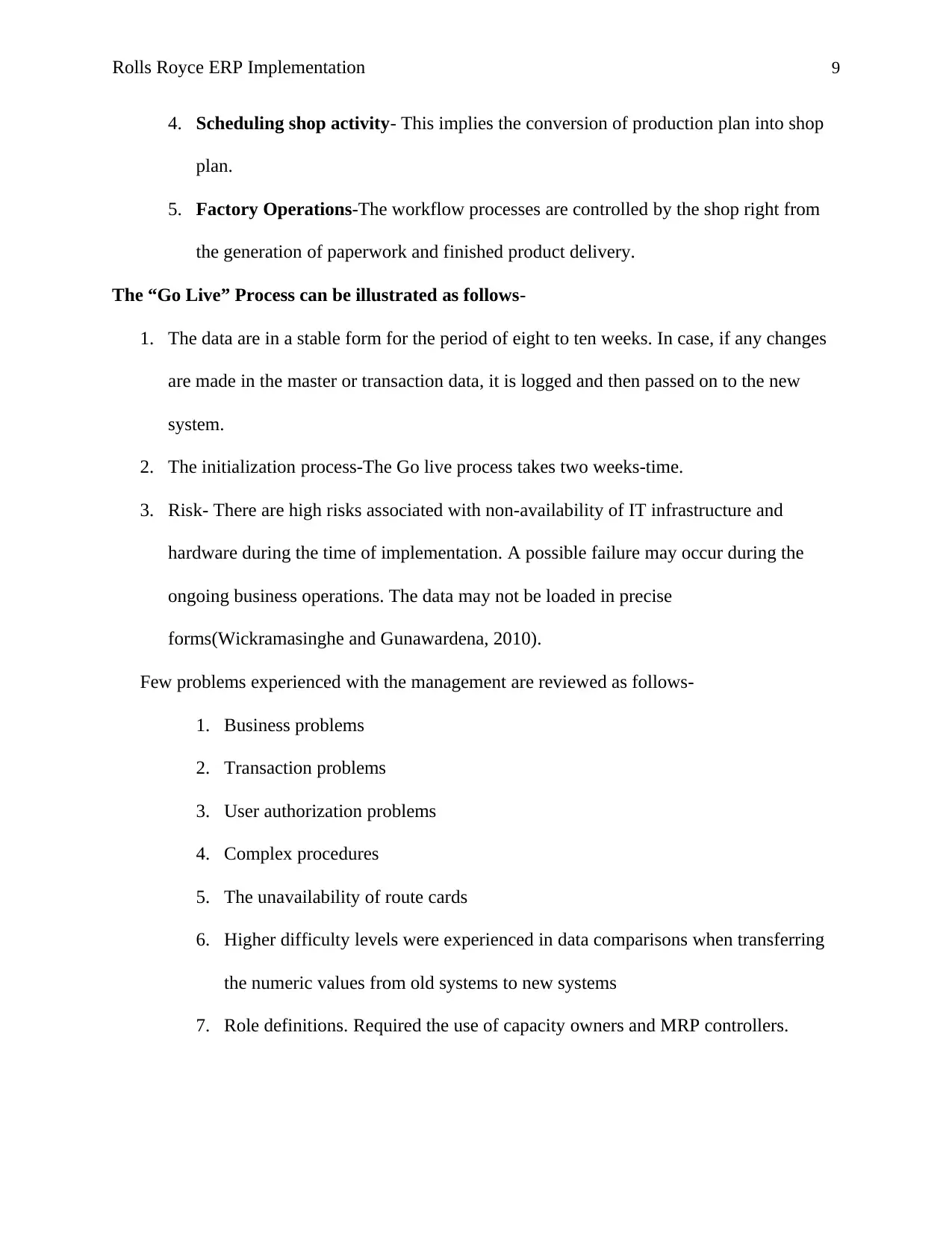
Rolls Royce ERP Implementation 9
4. Scheduling shop activity- This implies the conversion of production plan into shop
plan.
5. Factory Operations-The workflow processes are controlled by the shop right from
the generation of paperwork and finished product delivery.
The “Go Live” Process can be illustrated as follows-
1. The data are in a stable form for the period of eight to ten weeks. In case, if any changes
are made in the master or transaction data, it is logged and then passed on to the new
system.
2. The initialization process-The Go live process takes two weeks-time.
3. Risk- There are high risks associated with non-availability of IT infrastructure and
hardware during the time of implementation. A possible failure may occur during the
ongoing business operations. The data may not be loaded in precise
forms(Wickramasinghe and Gunawardena, 2010).
Few problems experienced with the management are reviewed as follows-
1. Business problems
2. Transaction problems
3. User authorization problems
4. Complex procedures
5. The unavailability of route cards
6. Higher difficulty levels were experienced in data comparisons when transferring
the numeric values from old systems to new systems
7. Role definitions. Required the use of capacity owners and MRP controllers.
4. Scheduling shop activity- This implies the conversion of production plan into shop
plan.
5. Factory Operations-The workflow processes are controlled by the shop right from
the generation of paperwork and finished product delivery.
The “Go Live” Process can be illustrated as follows-
1. The data are in a stable form for the period of eight to ten weeks. In case, if any changes
are made in the master or transaction data, it is logged and then passed on to the new
system.
2. The initialization process-The Go live process takes two weeks-time.
3. Risk- There are high risks associated with non-availability of IT infrastructure and
hardware during the time of implementation. A possible failure may occur during the
ongoing business operations. The data may not be loaded in precise
forms(Wickramasinghe and Gunawardena, 2010).
Few problems experienced with the management are reviewed as follows-
1. Business problems
2. Transaction problems
3. User authorization problems
4. Complex procedures
5. The unavailability of route cards
6. Higher difficulty levels were experienced in data comparisons when transferring
the numeric values from old systems to new systems
7. Role definitions. Required the use of capacity owners and MRP controllers.
Secure Best Marks with AI Grader
Need help grading? Try our AI Grader for instant feedback on your assignments.
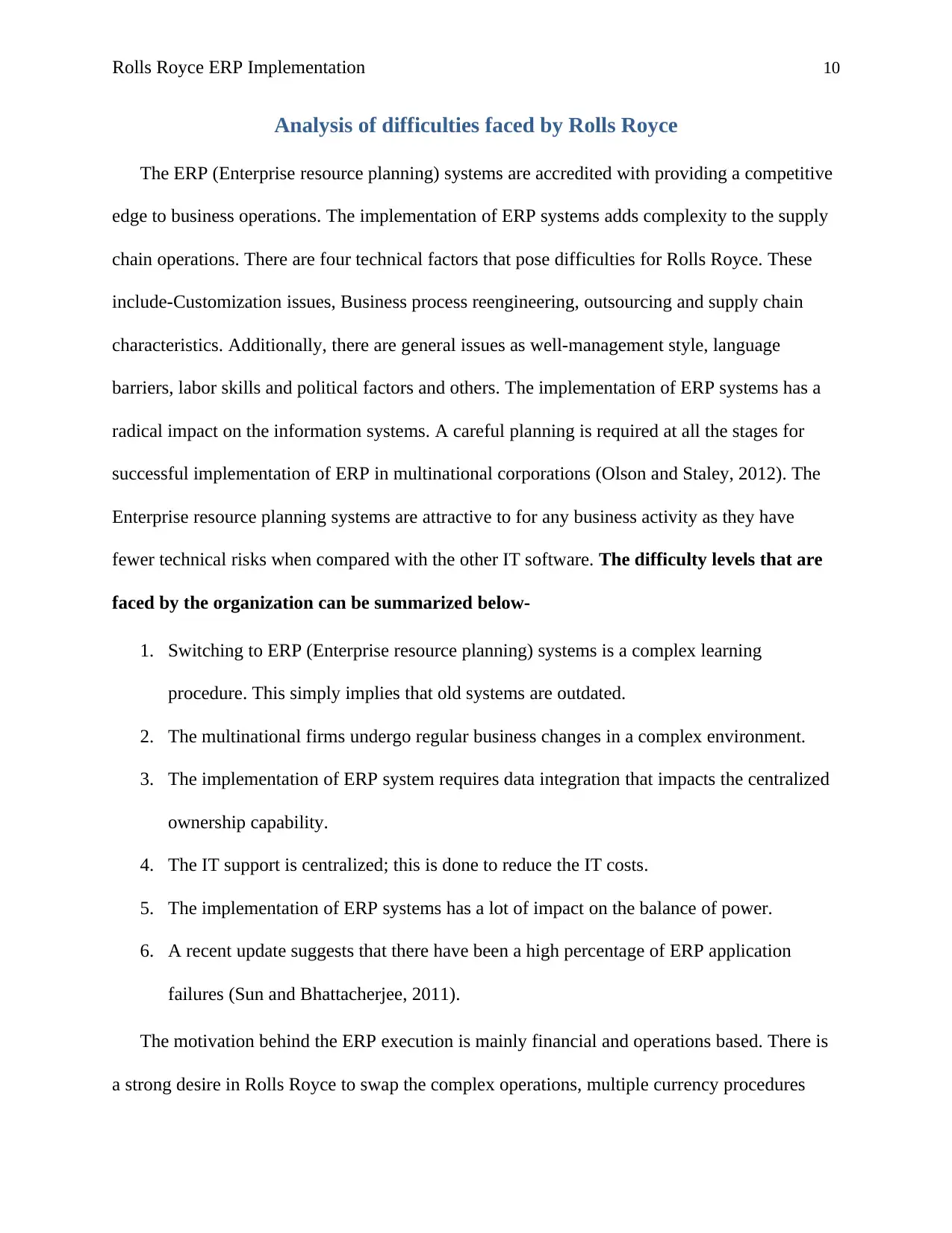
Rolls Royce ERP Implementation 10
Analysis of difficulties faced by Rolls Royce
The ERP (Enterprise resource planning) systems are accredited with providing a competitive
edge to business operations. The implementation of ERP systems adds complexity to the supply
chain operations. There are four technical factors that pose difficulties for Rolls Royce. These
include-Customization issues, Business process reengineering, outsourcing and supply chain
characteristics. Additionally, there are general issues as well-management style, language
barriers, labor skills and political factors and others. The implementation of ERP systems has a
radical impact on the information systems. A careful planning is required at all the stages for
successful implementation of ERP in multinational corporations (Olson and Staley, 2012). The
Enterprise resource planning systems are attractive to for any business activity as they have
fewer technical risks when compared with the other IT software. The difficulty levels that are
faced by the organization can be summarized below-
1. Switching to ERP (Enterprise resource planning) systems is a complex learning
procedure. This simply implies that old systems are outdated.
2. The multinational firms undergo regular business changes in a complex environment.
3. The implementation of ERP system requires data integration that impacts the centralized
ownership capability.
4. The IT support is centralized; this is done to reduce the IT costs.
5. The implementation of ERP systems has a lot of impact on the balance of power.
6. A recent update suggests that there have been a high percentage of ERP application
failures (Sun and Bhattacherjee, 2011).
The motivation behind the ERP execution is mainly financial and operations based. There is
a strong desire in Rolls Royce to swap the complex operations, multiple currency procedures
Analysis of difficulties faced by Rolls Royce
The ERP (Enterprise resource planning) systems are accredited with providing a competitive
edge to business operations. The implementation of ERP systems adds complexity to the supply
chain operations. There are four technical factors that pose difficulties for Rolls Royce. These
include-Customization issues, Business process reengineering, outsourcing and supply chain
characteristics. Additionally, there are general issues as well-management style, language
barriers, labor skills and political factors and others. The implementation of ERP systems has a
radical impact on the information systems. A careful planning is required at all the stages for
successful implementation of ERP in multinational corporations (Olson and Staley, 2012). The
Enterprise resource planning systems are attractive to for any business activity as they have
fewer technical risks when compared with the other IT software. The difficulty levels that are
faced by the organization can be summarized below-
1. Switching to ERP (Enterprise resource planning) systems is a complex learning
procedure. This simply implies that old systems are outdated.
2. The multinational firms undergo regular business changes in a complex environment.
3. The implementation of ERP system requires data integration that impacts the centralized
ownership capability.
4. The IT support is centralized; this is done to reduce the IT costs.
5. The implementation of ERP systems has a lot of impact on the balance of power.
6. A recent update suggests that there have been a high percentage of ERP application
failures (Sun and Bhattacherjee, 2011).
The motivation behind the ERP execution is mainly financial and operations based. There is
a strong desire in Rolls Royce to swap the complex operations, multiple currency procedures
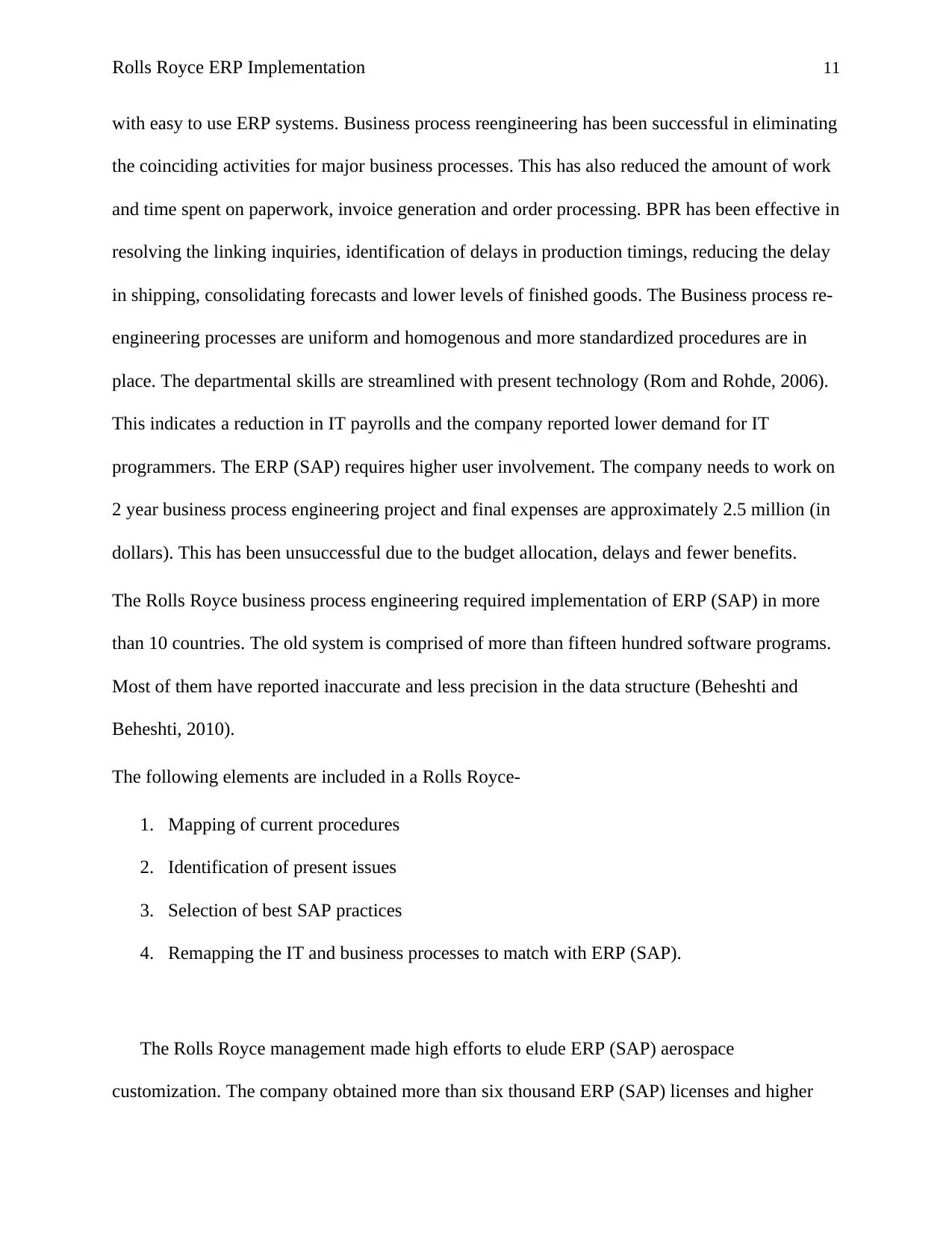
Rolls Royce ERP Implementation 11
with easy to use ERP systems. Business process reengineering has been successful in eliminating
the coinciding activities for major business processes. This has also reduced the amount of work
and time spent on paperwork, invoice generation and order processing. BPR has been effective in
resolving the linking inquiries, identification of delays in production timings, reducing the delay
in shipping, consolidating forecasts and lower levels of finished goods. The Business process re-
engineering processes are uniform and homogenous and more standardized procedures are in
place. The departmental skills are streamlined with present technology (Rom and Rohde, 2006).
This indicates a reduction in IT payrolls and the company reported lower demand for IT
programmers. The ERP (SAP) requires higher user involvement. The company needs to work on
2 year business process engineering project and final expenses are approximately 2.5 million (in
dollars). This has been unsuccessful due to the budget allocation, delays and fewer benefits.
The Rolls Royce business process engineering required implementation of ERP (SAP) in more
than 10 countries. The old system is comprised of more than fifteen hundred software programs.
Most of them have reported inaccurate and less precision in the data structure (Beheshti and
Beheshti, 2010).
The following elements are included in a Rolls Royce-
1. Mapping of current procedures
2. Identification of present issues
3. Selection of best SAP practices
4. Remapping the IT and business processes to match with ERP (SAP).
The Rolls Royce management made high efforts to elude ERP (SAP) aerospace
customization. The company obtained more than six thousand ERP (SAP) licenses and higher
with easy to use ERP systems. Business process reengineering has been successful in eliminating
the coinciding activities for major business processes. This has also reduced the amount of work
and time spent on paperwork, invoice generation and order processing. BPR has been effective in
resolving the linking inquiries, identification of delays in production timings, reducing the delay
in shipping, consolidating forecasts and lower levels of finished goods. The Business process re-
engineering processes are uniform and homogenous and more standardized procedures are in
place. The departmental skills are streamlined with present technology (Rom and Rohde, 2006).
This indicates a reduction in IT payrolls and the company reported lower demand for IT
programmers. The ERP (SAP) requires higher user involvement. The company needs to work on
2 year business process engineering project and final expenses are approximately 2.5 million (in
dollars). This has been unsuccessful due to the budget allocation, delays and fewer benefits.
The Rolls Royce business process engineering required implementation of ERP (SAP) in more
than 10 countries. The old system is comprised of more than fifteen hundred software programs.
Most of them have reported inaccurate and less precision in the data structure (Beheshti and
Beheshti, 2010).
The following elements are included in a Rolls Royce-
1. Mapping of current procedures
2. Identification of present issues
3. Selection of best SAP practices
4. Remapping the IT and business processes to match with ERP (SAP).
The Rolls Royce management made high efforts to elude ERP (SAP) aerospace
customization. The company obtained more than six thousand ERP (SAP) licenses and higher
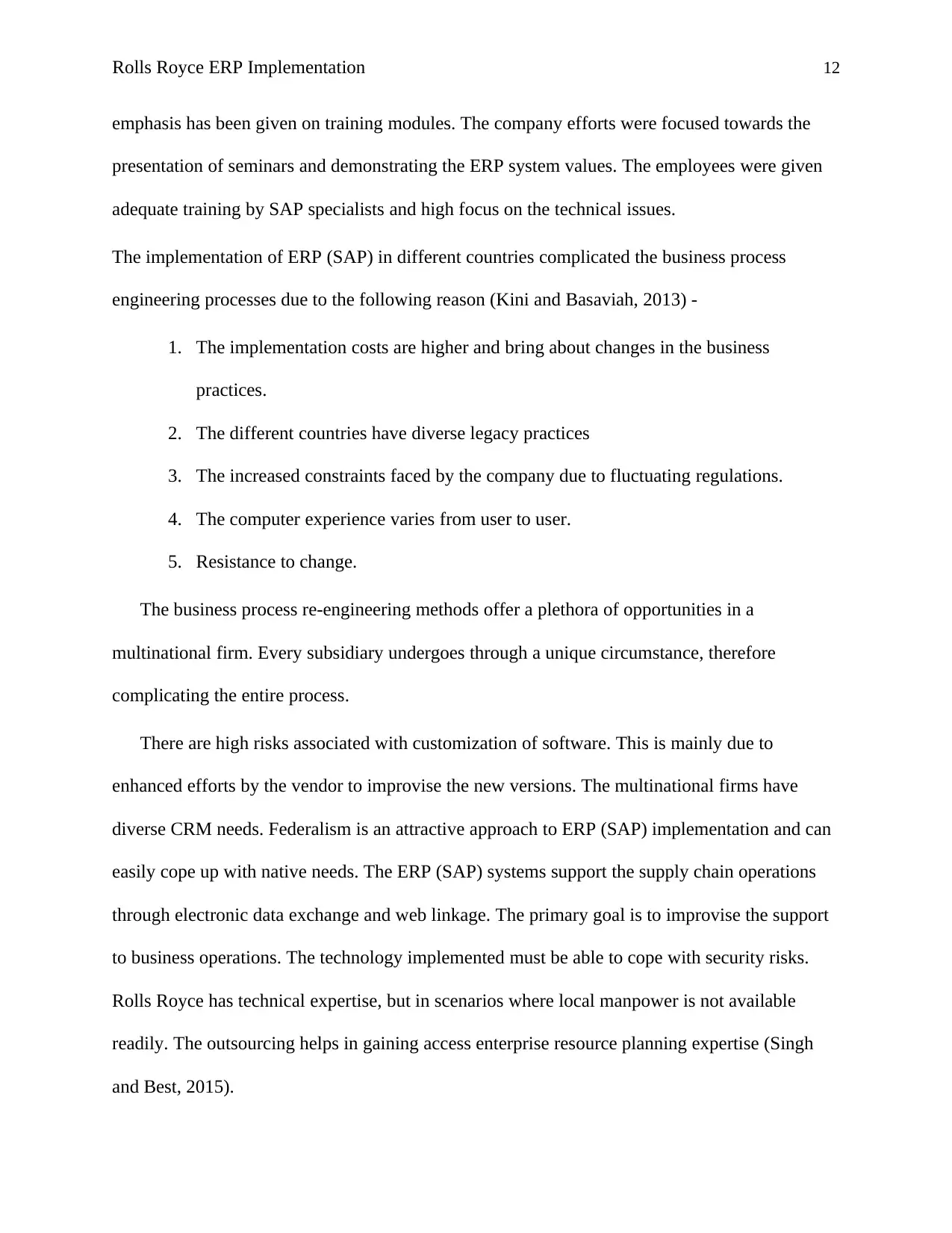
Rolls Royce ERP Implementation 12
emphasis has been given on training modules. The company efforts were focused towards the
presentation of seminars and demonstrating the ERP system values. The employees were given
adequate training by SAP specialists and high focus on the technical issues.
The implementation of ERP (SAP) in different countries complicated the business process
engineering processes due to the following reason (Kini and Basaviah, 2013) -
1. The implementation costs are higher and bring about changes in the business
practices.
2. The different countries have diverse legacy practices
3. The increased constraints faced by the company due to fluctuating regulations.
4. The computer experience varies from user to user.
5. Resistance to change.
The business process re-engineering methods offer a plethora of opportunities in a
multinational firm. Every subsidiary undergoes through a unique circumstance, therefore
complicating the entire process.
There are high risks associated with customization of software. This is mainly due to
enhanced efforts by the vendor to improvise the new versions. The multinational firms have
diverse CRM needs. Federalism is an attractive approach to ERP (SAP) implementation and can
easily cope up with native needs. The ERP (SAP) systems support the supply chain operations
through electronic data exchange and web linkage. The primary goal is to improvise the support
to business operations. The technology implemented must be able to cope with security risks.
Rolls Royce has technical expertise, but in scenarios where local manpower is not available
readily. The outsourcing helps in gaining access enterprise resource planning expertise (Singh
and Best, 2015).
emphasis has been given on training modules. The company efforts were focused towards the
presentation of seminars and demonstrating the ERP system values. The employees were given
adequate training by SAP specialists and high focus on the technical issues.
The implementation of ERP (SAP) in different countries complicated the business process
engineering processes due to the following reason (Kini and Basaviah, 2013) -
1. The implementation costs are higher and bring about changes in the business
practices.
2. The different countries have diverse legacy practices
3. The increased constraints faced by the company due to fluctuating regulations.
4. The computer experience varies from user to user.
5. Resistance to change.
The business process re-engineering methods offer a plethora of opportunities in a
multinational firm. Every subsidiary undergoes through a unique circumstance, therefore
complicating the entire process.
There are high risks associated with customization of software. This is mainly due to
enhanced efforts by the vendor to improvise the new versions. The multinational firms have
diverse CRM needs. Federalism is an attractive approach to ERP (SAP) implementation and can
easily cope up with native needs. The ERP (SAP) systems support the supply chain operations
through electronic data exchange and web linkage. The primary goal is to improvise the support
to business operations. The technology implemented must be able to cope with security risks.
Rolls Royce has technical expertise, but in scenarios where local manpower is not available
readily. The outsourcing helps in gaining access enterprise resource planning expertise (Singh
and Best, 2015).
Paraphrase This Document
Need a fresh take? Get an instant paraphrase of this document with our AI Paraphraser
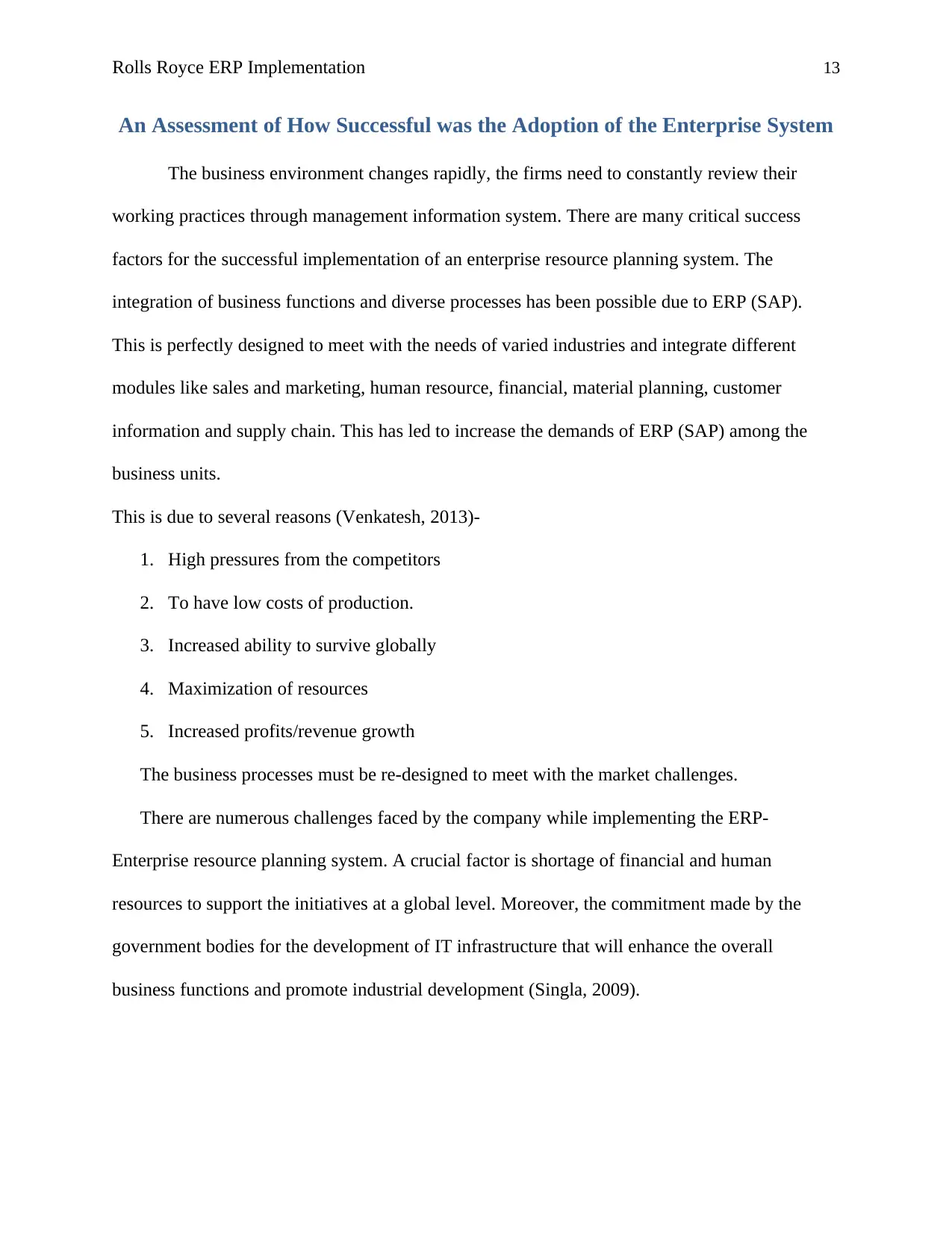
Rolls Royce ERP Implementation 13
An Assessment of How Successful was the Adoption of the Enterprise System
The business environment changes rapidly, the firms need to constantly review their
working practices through management information system. There are many critical success
factors for the successful implementation of an enterprise resource planning system. The
integration of business functions and diverse processes has been possible due to ERP (SAP).
This is perfectly designed to meet with the needs of varied industries and integrate different
modules like sales and marketing, human resource, financial, material planning, customer
information and supply chain. This has led to increase the demands of ERP (SAP) among the
business units.
This is due to several reasons (Venkatesh, 2013)-
1. High pressures from the competitors
2. To have low costs of production.
3. Increased ability to survive globally
4. Maximization of resources
5. Increased profits/revenue growth
The business processes must be re-designed to meet with the market challenges.
There are numerous challenges faced by the company while implementing the ERP-
Enterprise resource planning system. A crucial factor is shortage of financial and human
resources to support the initiatives at a global level. Moreover, the commitment made by the
government bodies for the development of IT infrastructure that will enhance the overall
business functions and promote industrial development (Singla, 2009).
An Assessment of How Successful was the Adoption of the Enterprise System
The business environment changes rapidly, the firms need to constantly review their
working practices through management information system. There are many critical success
factors for the successful implementation of an enterprise resource planning system. The
integration of business functions and diverse processes has been possible due to ERP (SAP).
This is perfectly designed to meet with the needs of varied industries and integrate different
modules like sales and marketing, human resource, financial, material planning, customer
information and supply chain. This has led to increase the demands of ERP (SAP) among the
business units.
This is due to several reasons (Venkatesh, 2013)-
1. High pressures from the competitors
2. To have low costs of production.
3. Increased ability to survive globally
4. Maximization of resources
5. Increased profits/revenue growth
The business processes must be re-designed to meet with the market challenges.
There are numerous challenges faced by the company while implementing the ERP-
Enterprise resource planning system. A crucial factor is shortage of financial and human
resources to support the initiatives at a global level. Moreover, the commitment made by the
government bodies for the development of IT infrastructure that will enhance the overall
business functions and promote industrial development (Singla, 2009).
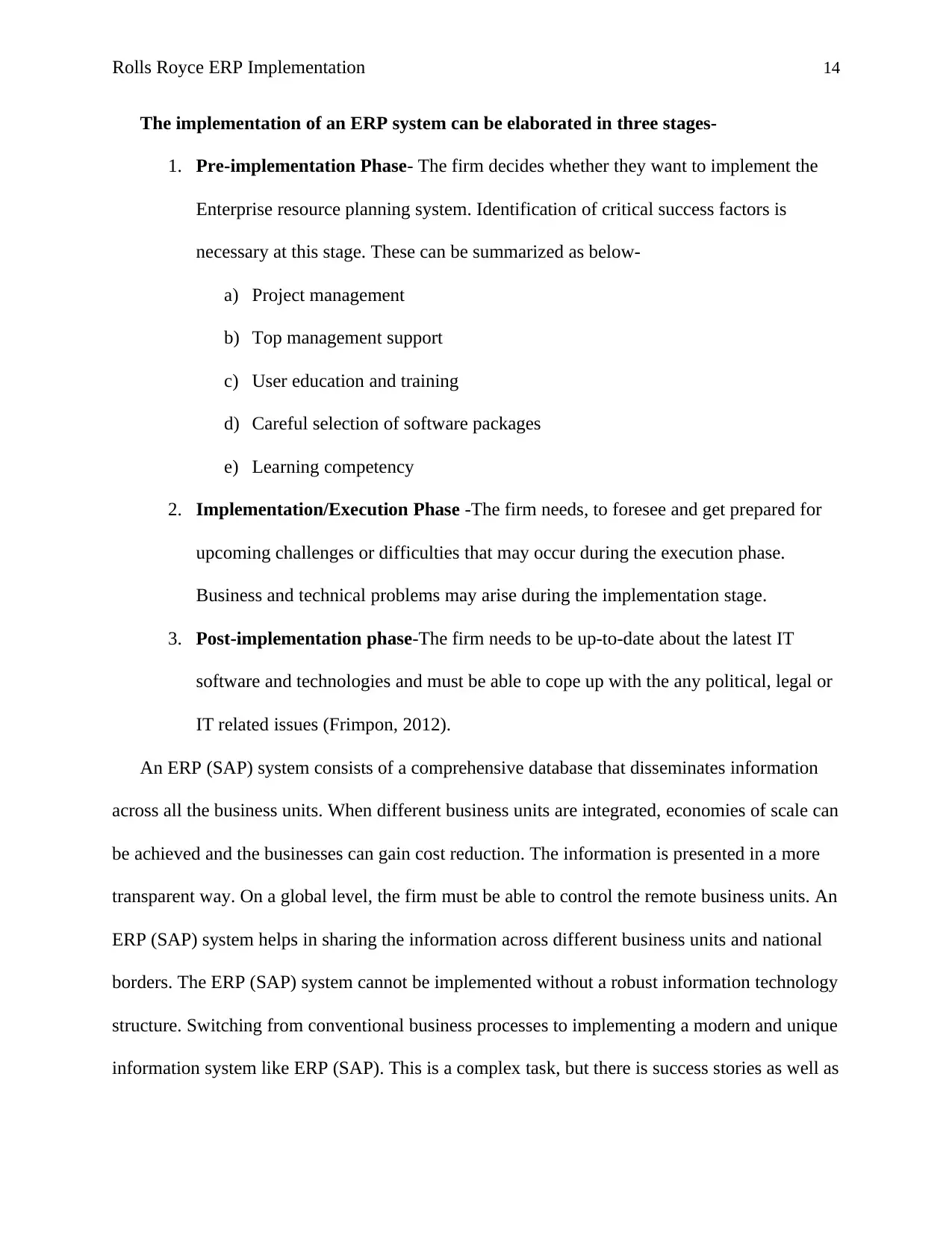
Rolls Royce ERP Implementation 14
The implementation of an ERP system can be elaborated in three stages-
1. Pre-implementation Phase- The firm decides whether they want to implement the
Enterprise resource planning system. Identification of critical success factors is
necessary at this stage. These can be summarized as below-
a) Project management
b) Top management support
c) User education and training
d) Careful selection of software packages
e) Learning competency
2. Implementation/Execution Phase -The firm needs, to foresee and get prepared for
upcoming challenges or difficulties that may occur during the execution phase.
Business and technical problems may arise during the implementation stage.
3. Post-implementation phase-The firm needs to be up-to-date about the latest IT
software and technologies and must be able to cope up with the any political, legal or
IT related issues (Frimpon, 2012).
An ERP (SAP) system consists of a comprehensive database that disseminates information
across all the business units. When different business units are integrated, economies of scale can
be achieved and the businesses can gain cost reduction. The information is presented in a more
transparent way. On a global level, the firm must be able to control the remote business units. An
ERP (SAP) system helps in sharing the information across different business units and national
borders. The ERP (SAP) system cannot be implemented without a robust information technology
structure. Switching from conventional business processes to implementing a modern and unique
information system like ERP (SAP). This is a complex task, but there is success stories as well as
The implementation of an ERP system can be elaborated in three stages-
1. Pre-implementation Phase- The firm decides whether they want to implement the
Enterprise resource planning system. Identification of critical success factors is
necessary at this stage. These can be summarized as below-
a) Project management
b) Top management support
c) User education and training
d) Careful selection of software packages
e) Learning competency
2. Implementation/Execution Phase -The firm needs, to foresee and get prepared for
upcoming challenges or difficulties that may occur during the execution phase.
Business and technical problems may arise during the implementation stage.
3. Post-implementation phase-The firm needs to be up-to-date about the latest IT
software and technologies and must be able to cope up with the any political, legal or
IT related issues (Frimpon, 2012).
An ERP (SAP) system consists of a comprehensive database that disseminates information
across all the business units. When different business units are integrated, economies of scale can
be achieved and the businesses can gain cost reduction. The information is presented in a more
transparent way. On a global level, the firm must be able to control the remote business units. An
ERP (SAP) system helps in sharing the information across different business units and national
borders. The ERP (SAP) system cannot be implemented without a robust information technology
structure. Switching from conventional business processes to implementing a modern and unique
information system like ERP (SAP). This is a complex task, but there is success stories as well as
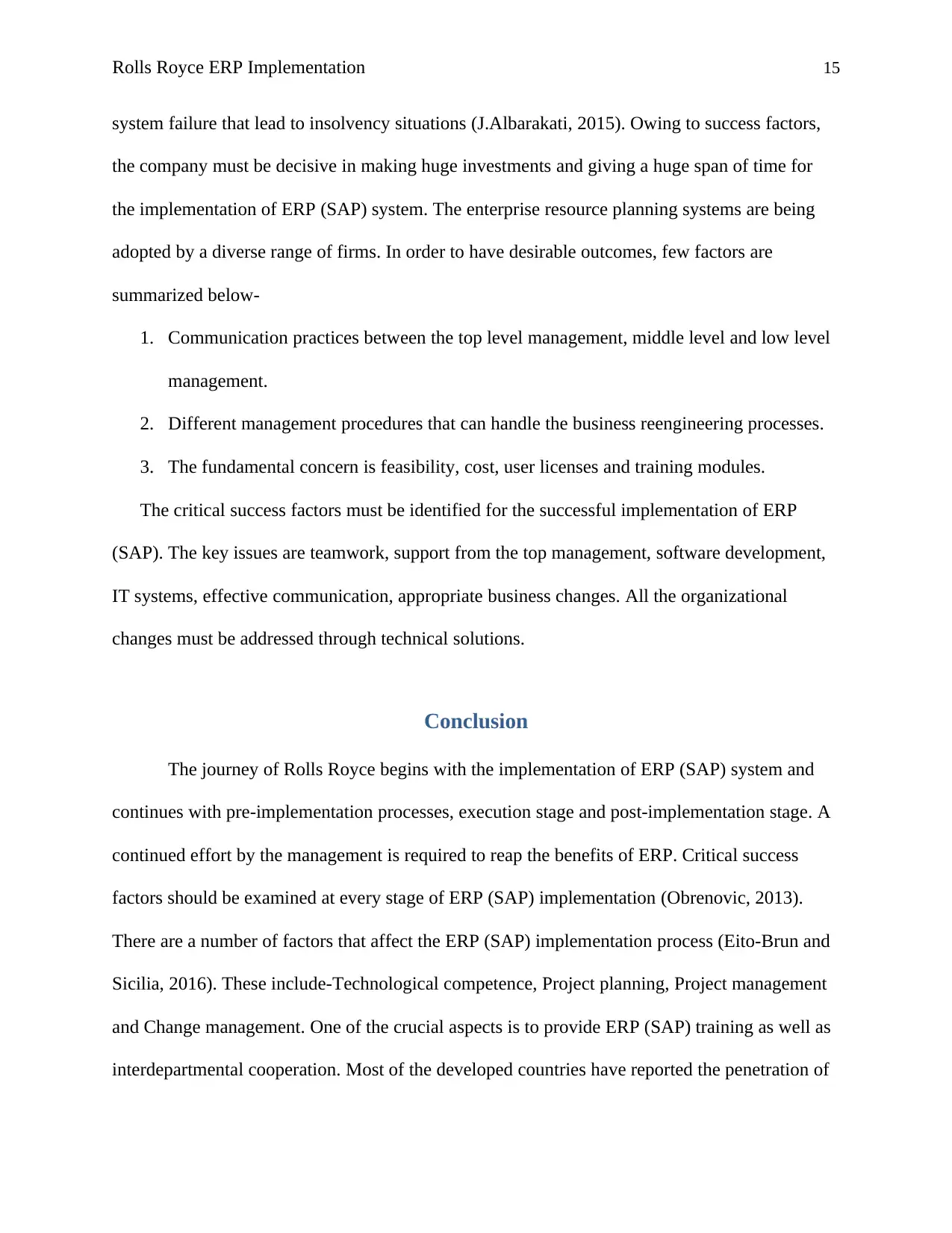
Rolls Royce ERP Implementation 15
system failure that lead to insolvency situations (J.Albarakati, 2015). Owing to success factors,
the company must be decisive in making huge investments and giving a huge span of time for
the implementation of ERP (SAP) system. The enterprise resource planning systems are being
adopted by a diverse range of firms. In order to have desirable outcomes, few factors are
summarized below-
1. Communication practices between the top level management, middle level and low level
management.
2. Different management procedures that can handle the business reengineering processes.
3. The fundamental concern is feasibility, cost, user licenses and training modules.
The critical success factors must be identified for the successful implementation of ERP
(SAP). The key issues are teamwork, support from the top management, software development,
IT systems, effective communication, appropriate business changes. All the organizational
changes must be addressed through technical solutions.
Conclusion
The journey of Rolls Royce begins with the implementation of ERP (SAP) system and
continues with pre-implementation processes, execution stage and post-implementation stage. A
continued effort by the management is required to reap the benefits of ERP. Critical success
factors should be examined at every stage of ERP (SAP) implementation (Obrenovic, 2013).
There are a number of factors that affect the ERP (SAP) implementation process (Eito-Brun and
Sicilia, 2016). These include-Technological competence, Project planning, Project management
and Change management. One of the crucial aspects is to provide ERP (SAP) training as well as
interdepartmental cooperation. Most of the developed countries have reported the penetration of
system failure that lead to insolvency situations (J.Albarakati, 2015). Owing to success factors,
the company must be decisive in making huge investments and giving a huge span of time for
the implementation of ERP (SAP) system. The enterprise resource planning systems are being
adopted by a diverse range of firms. In order to have desirable outcomes, few factors are
summarized below-
1. Communication practices between the top level management, middle level and low level
management.
2. Different management procedures that can handle the business reengineering processes.
3. The fundamental concern is feasibility, cost, user licenses and training modules.
The critical success factors must be identified for the successful implementation of ERP
(SAP). The key issues are teamwork, support from the top management, software development,
IT systems, effective communication, appropriate business changes. All the organizational
changes must be addressed through technical solutions.
Conclusion
The journey of Rolls Royce begins with the implementation of ERP (SAP) system and
continues with pre-implementation processes, execution stage and post-implementation stage. A
continued effort by the management is required to reap the benefits of ERP. Critical success
factors should be examined at every stage of ERP (SAP) implementation (Obrenovic, 2013).
There are a number of factors that affect the ERP (SAP) implementation process (Eito-Brun and
Sicilia, 2016). These include-Technological competence, Project planning, Project management
and Change management. One of the crucial aspects is to provide ERP (SAP) training as well as
interdepartmental cooperation. Most of the developed countries have reported the penetration of
Secure Best Marks with AI Grader
Need help grading? Try our AI Grader for instant feedback on your assignments.
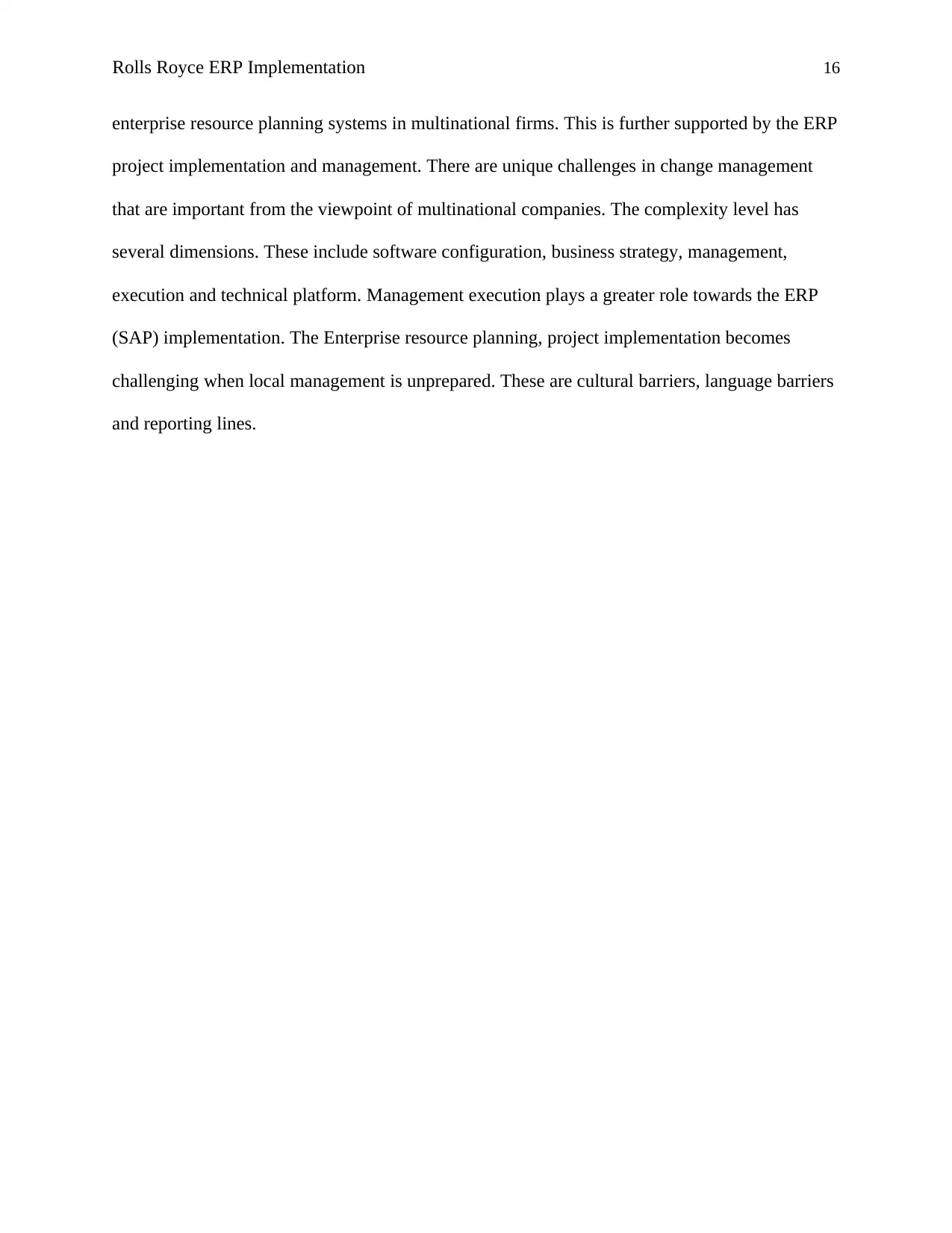
Rolls Royce ERP Implementation 16
enterprise resource planning systems in multinational firms. This is further supported by the ERP
project implementation and management. There are unique challenges in change management
that are important from the viewpoint of multinational companies. The complexity level has
several dimensions. These include software configuration, business strategy, management,
execution and technical platform. Management execution plays a greater role towards the ERP
(SAP) implementation. The Enterprise resource planning, project implementation becomes
challenging when local management is unprepared. These are cultural barriers, language barriers
and reporting lines.
enterprise resource planning systems in multinational firms. This is further supported by the ERP
project implementation and management. There are unique challenges in change management
that are important from the viewpoint of multinational companies. The complexity level has
several dimensions. These include software configuration, business strategy, management,
execution and technical platform. Management execution plays a greater role towards the ERP
(SAP) implementation. The Enterprise resource planning, project implementation becomes
challenging when local management is unprepared. These are cultural barriers, language barriers
and reporting lines.
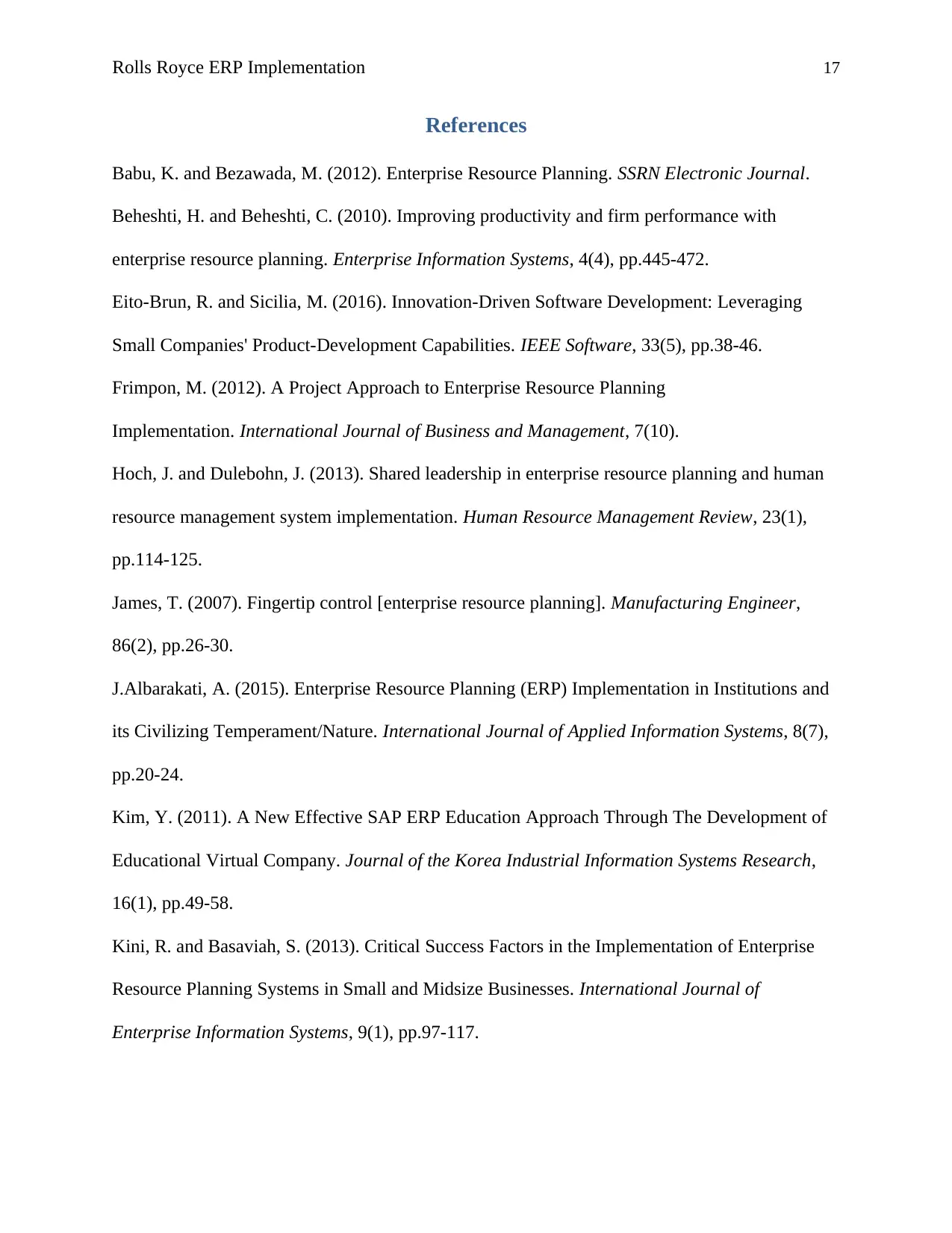
Rolls Royce ERP Implementation 17
References
Babu, K. and Bezawada, M. (2012). Enterprise Resource Planning. SSRN Electronic Journal.
Beheshti, H. and Beheshti, C. (2010). Improving productivity and firm performance with
enterprise resource planning. Enterprise Information Systems, 4(4), pp.445-472.
Eito-Brun, R. and Sicilia, M. (2016). Innovation-Driven Software Development: Leveraging
Small Companies' Product-Development Capabilities. IEEE Software, 33(5), pp.38-46.
Frimpon, M. (2012). A Project Approach to Enterprise Resource Planning
Implementation. International Journal of Business and Management, 7(10).
Hoch, J. and Dulebohn, J. (2013). Shared leadership in enterprise resource planning and human
resource management system implementation. Human Resource Management Review, 23(1),
pp.114-125.
James, T. (2007). Fingertip control [enterprise resource planning]. Manufacturing Engineer,
86(2), pp.26-30.
J.Albarakati, A. (2015). Enterprise Resource Planning (ERP) Implementation in Institutions and
its Civilizing Temperament/Nature. International Journal of Applied Information Systems, 8(7),
pp.20-24.
Kim, Y. (2011). A New Effective SAP ERP Education Approach Through The Development of
Educational Virtual Company. Journal of the Korea Industrial Information Systems Research,
16(1), pp.49-58.
Kini, R. and Basaviah, S. (2013). Critical Success Factors in the Implementation of Enterprise
Resource Planning Systems in Small and Midsize Businesses. International Journal of
Enterprise Information Systems, 9(1), pp.97-117.
References
Babu, K. and Bezawada, M. (2012). Enterprise Resource Planning. SSRN Electronic Journal.
Beheshti, H. and Beheshti, C. (2010). Improving productivity and firm performance with
enterprise resource planning. Enterprise Information Systems, 4(4), pp.445-472.
Eito-Brun, R. and Sicilia, M. (2016). Innovation-Driven Software Development: Leveraging
Small Companies' Product-Development Capabilities. IEEE Software, 33(5), pp.38-46.
Frimpon, M. (2012). A Project Approach to Enterprise Resource Planning
Implementation. International Journal of Business and Management, 7(10).
Hoch, J. and Dulebohn, J. (2013). Shared leadership in enterprise resource planning and human
resource management system implementation. Human Resource Management Review, 23(1),
pp.114-125.
James, T. (2007). Fingertip control [enterprise resource planning]. Manufacturing Engineer,
86(2), pp.26-30.
J.Albarakati, A. (2015). Enterprise Resource Planning (ERP) Implementation in Institutions and
its Civilizing Temperament/Nature. International Journal of Applied Information Systems, 8(7),
pp.20-24.
Kim, Y. (2011). A New Effective SAP ERP Education Approach Through The Development of
Educational Virtual Company. Journal of the Korea Industrial Information Systems Research,
16(1), pp.49-58.
Kini, R. and Basaviah, S. (2013). Critical Success Factors in the Implementation of Enterprise
Resource Planning Systems in Small and Midsize Businesses. International Journal of
Enterprise Information Systems, 9(1), pp.97-117.
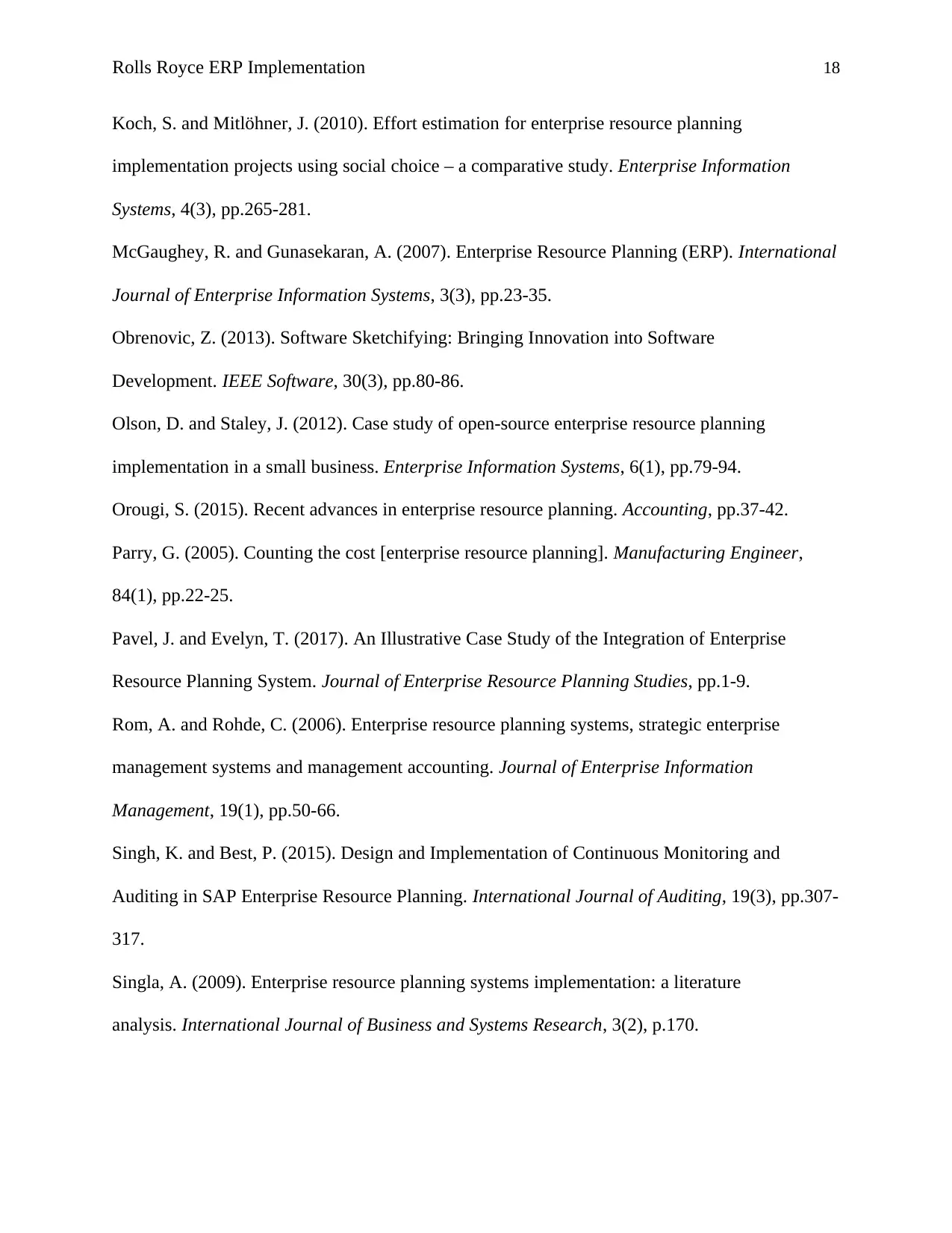
Rolls Royce ERP Implementation 18
Koch, S. and Mitlöhner, J. (2010). Effort estimation for enterprise resource planning
implementation projects using social choice – a comparative study. Enterprise Information
Systems, 4(3), pp.265-281.
McGaughey, R. and Gunasekaran, A. (2007). Enterprise Resource Planning (ERP). International
Journal of Enterprise Information Systems, 3(3), pp.23-35.
Obrenovic, Z. (2013). Software Sketchifying: Bringing Innovation into Software
Development. IEEE Software, 30(3), pp.80-86.
Olson, D. and Staley, J. (2012). Case study of open-source enterprise resource planning
implementation in a small business. Enterprise Information Systems, 6(1), pp.79-94.
Orougi, S. (2015). Recent advances in enterprise resource planning. Accounting, pp.37-42.
Parry, G. (2005). Counting the cost [enterprise resource planning]. Manufacturing Engineer,
84(1), pp.22-25.
Pavel, J. and Evelyn, T. (2017). An Illustrative Case Study of the Integration of Enterprise
Resource Planning System. Journal of Enterprise Resource Planning Studies, pp.1-9.
Rom, A. and Rohde, C. (2006). Enterprise resource planning systems, strategic enterprise
management systems and management accounting. Journal of Enterprise Information
Management, 19(1), pp.50-66.
Singh, K. and Best, P. (2015). Design and Implementation of Continuous Monitoring and
Auditing in SAP Enterprise Resource Planning. International Journal of Auditing, 19(3), pp.307-
317.
Singla, A. (2009). Enterprise resource planning systems implementation: a literature
analysis. International Journal of Business and Systems Research, 3(2), p.170.
Koch, S. and Mitlöhner, J. (2010). Effort estimation for enterprise resource planning
implementation projects using social choice – a comparative study. Enterprise Information
Systems, 4(3), pp.265-281.
McGaughey, R. and Gunasekaran, A. (2007). Enterprise Resource Planning (ERP). International
Journal of Enterprise Information Systems, 3(3), pp.23-35.
Obrenovic, Z. (2013). Software Sketchifying: Bringing Innovation into Software
Development. IEEE Software, 30(3), pp.80-86.
Olson, D. and Staley, J. (2012). Case study of open-source enterprise resource planning
implementation in a small business. Enterprise Information Systems, 6(1), pp.79-94.
Orougi, S. (2015). Recent advances in enterprise resource planning. Accounting, pp.37-42.
Parry, G. (2005). Counting the cost [enterprise resource planning]. Manufacturing Engineer,
84(1), pp.22-25.
Pavel, J. and Evelyn, T. (2017). An Illustrative Case Study of the Integration of Enterprise
Resource Planning System. Journal of Enterprise Resource Planning Studies, pp.1-9.
Rom, A. and Rohde, C. (2006). Enterprise resource planning systems, strategic enterprise
management systems and management accounting. Journal of Enterprise Information
Management, 19(1), pp.50-66.
Singh, K. and Best, P. (2015). Design and Implementation of Continuous Monitoring and
Auditing in SAP Enterprise Resource Planning. International Journal of Auditing, 19(3), pp.307-
317.
Singla, A. (2009). Enterprise resource planning systems implementation: a literature
analysis. International Journal of Business and Systems Research, 3(2), p.170.
Paraphrase This Document
Need a fresh take? Get an instant paraphrase of this document with our AI Paraphraser
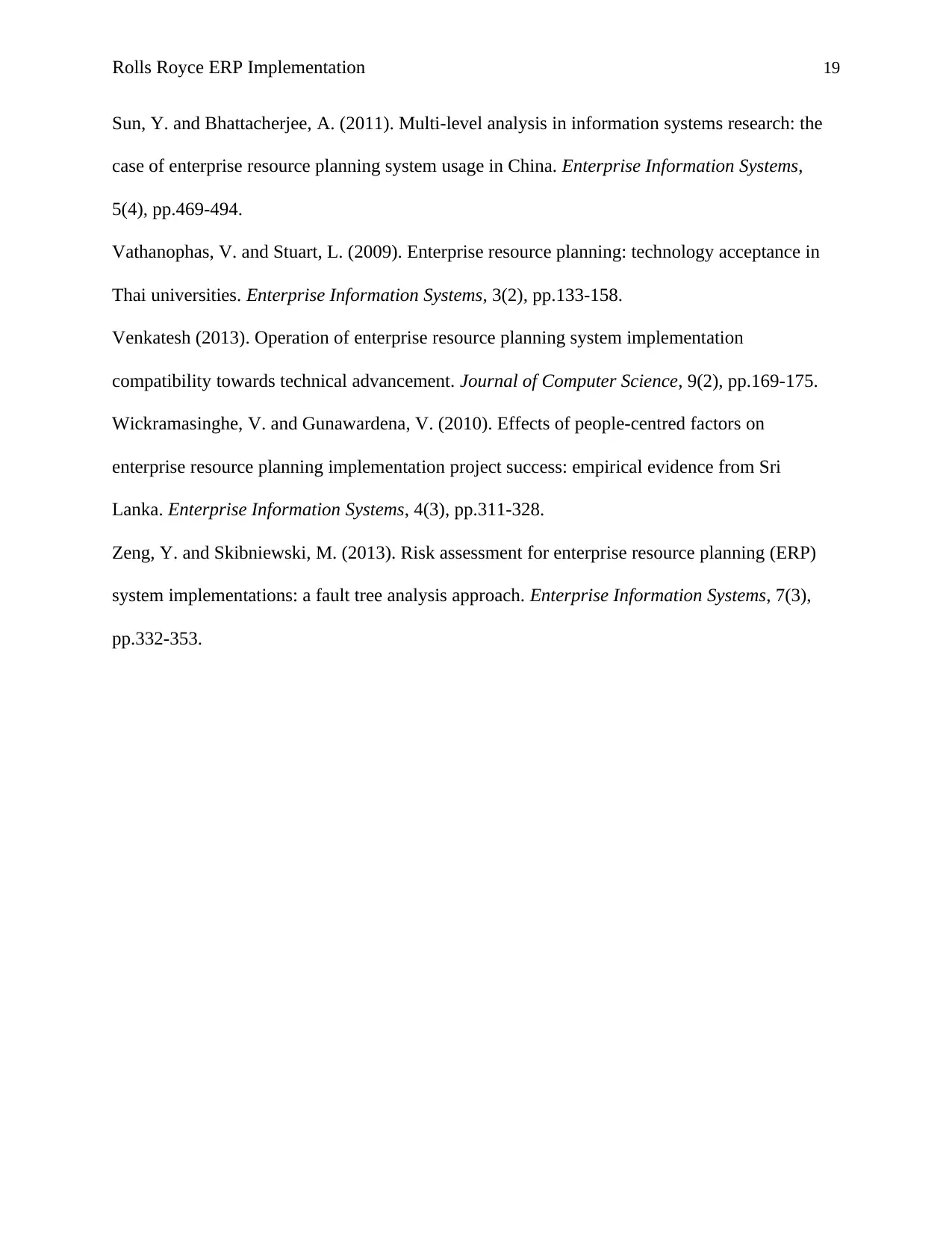
Rolls Royce ERP Implementation 19
Sun, Y. and Bhattacherjee, A. (2011). Multi-level analysis in information systems research: the
case of enterprise resource planning system usage in China. Enterprise Information Systems,
5(4), pp.469-494.
Vathanophas, V. and Stuart, L. (2009). Enterprise resource planning: technology acceptance in
Thai universities. Enterprise Information Systems, 3(2), pp.133-158.
Venkatesh (2013). Operation of enterprise resource planning system implementation
compatibility towards technical advancement. Journal of Computer Science, 9(2), pp.169-175.
Wickramasinghe, V. and Gunawardena, V. (2010). Effects of people-centred factors on
enterprise resource planning implementation project success: empirical evidence from Sri
Lanka. Enterprise Information Systems, 4(3), pp.311-328.
Zeng, Y. and Skibniewski, M. (2013). Risk assessment for enterprise resource planning (ERP)
system implementations: a fault tree analysis approach. Enterprise Information Systems, 7(3),
pp.332-353.
Sun, Y. and Bhattacherjee, A. (2011). Multi-level analysis in information systems research: the
case of enterprise resource planning system usage in China. Enterprise Information Systems,
5(4), pp.469-494.
Vathanophas, V. and Stuart, L. (2009). Enterprise resource planning: technology acceptance in
Thai universities. Enterprise Information Systems, 3(2), pp.133-158.
Venkatesh (2013). Operation of enterprise resource planning system implementation
compatibility towards technical advancement. Journal of Computer Science, 9(2), pp.169-175.
Wickramasinghe, V. and Gunawardena, V. (2010). Effects of people-centred factors on
enterprise resource planning implementation project success: empirical evidence from Sri
Lanka. Enterprise Information Systems, 4(3), pp.311-328.
Zeng, Y. and Skibniewski, M. (2013). Risk assessment for enterprise resource planning (ERP)
system implementations: a fault tree analysis approach. Enterprise Information Systems, 7(3),
pp.332-353.
1 out of 20
Related Documents
Your All-in-One AI-Powered Toolkit for Academic Success.
+13062052269
info@desklib.com
Available 24*7 on WhatsApp / Email
![[object Object]](/_next/static/media/star-bottom.7253800d.svg)
Unlock your academic potential
© 2024 | Zucol Services PVT LTD | All rights reserved.





